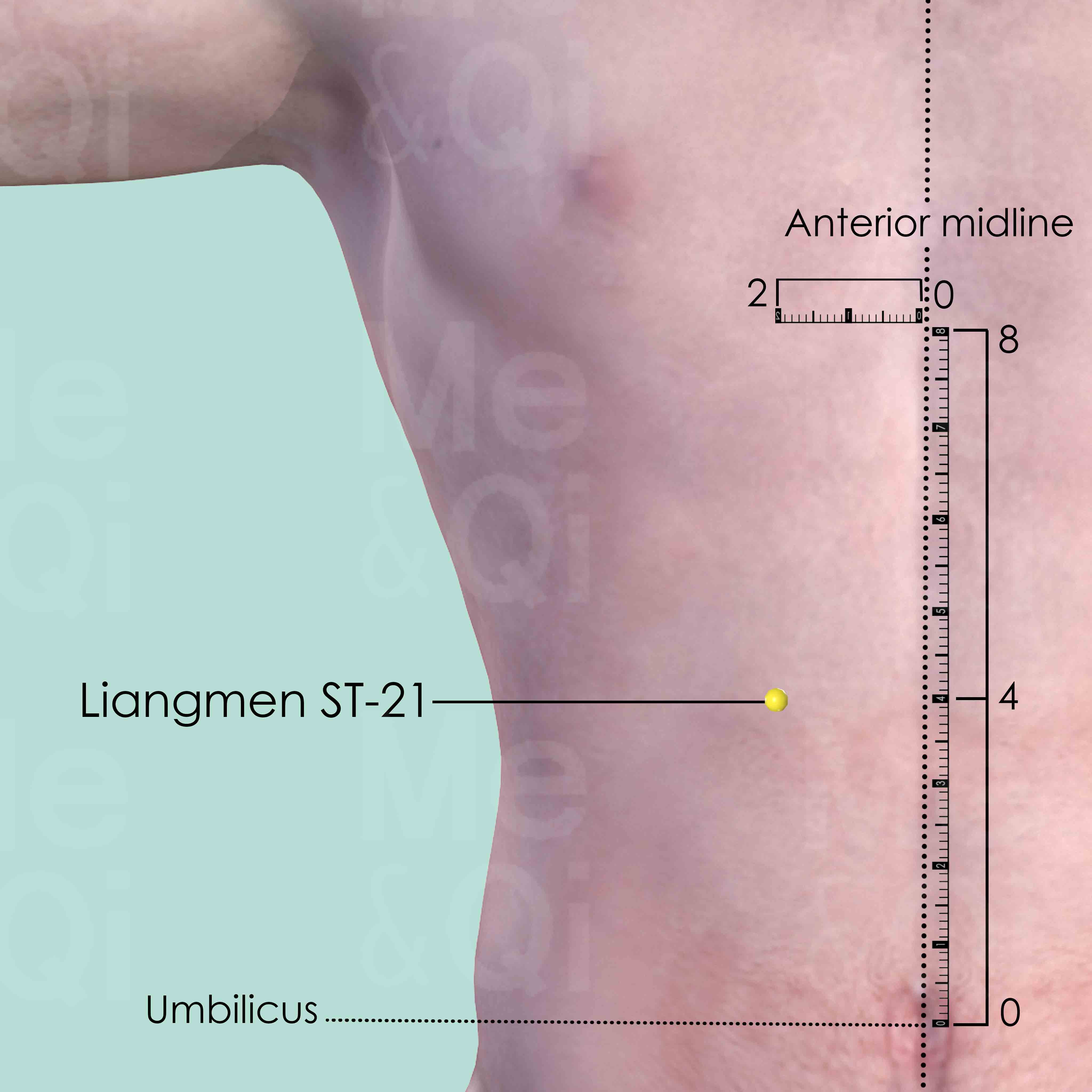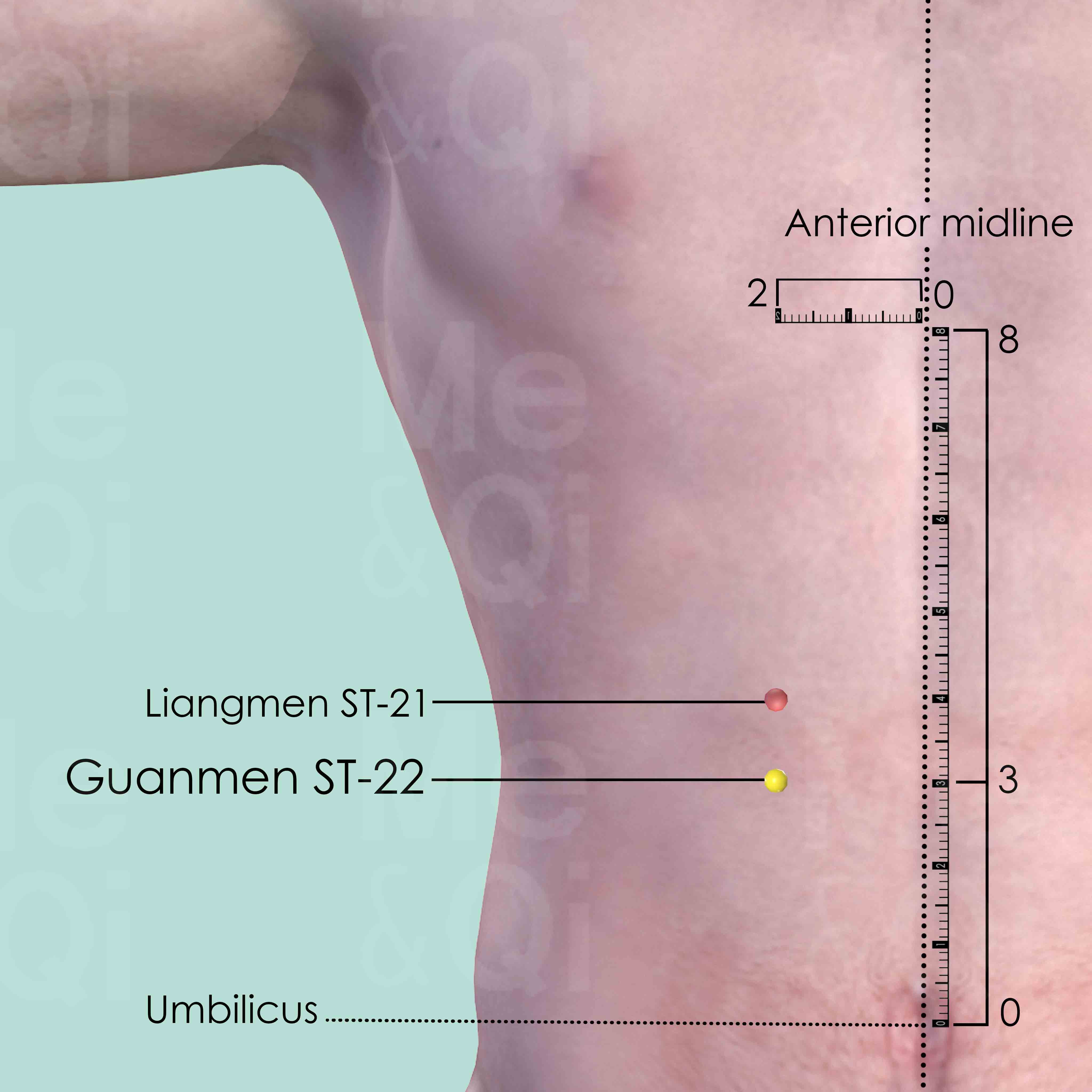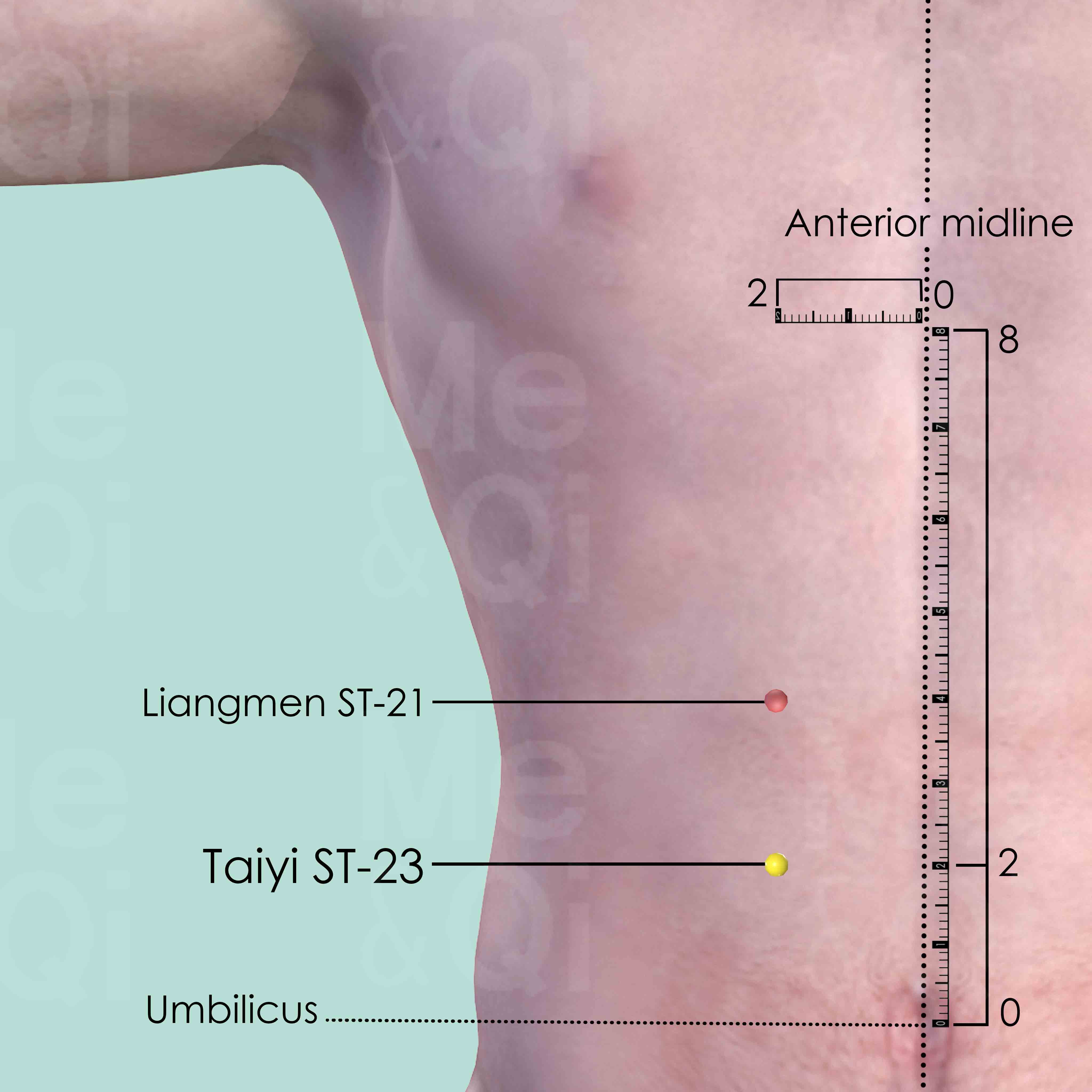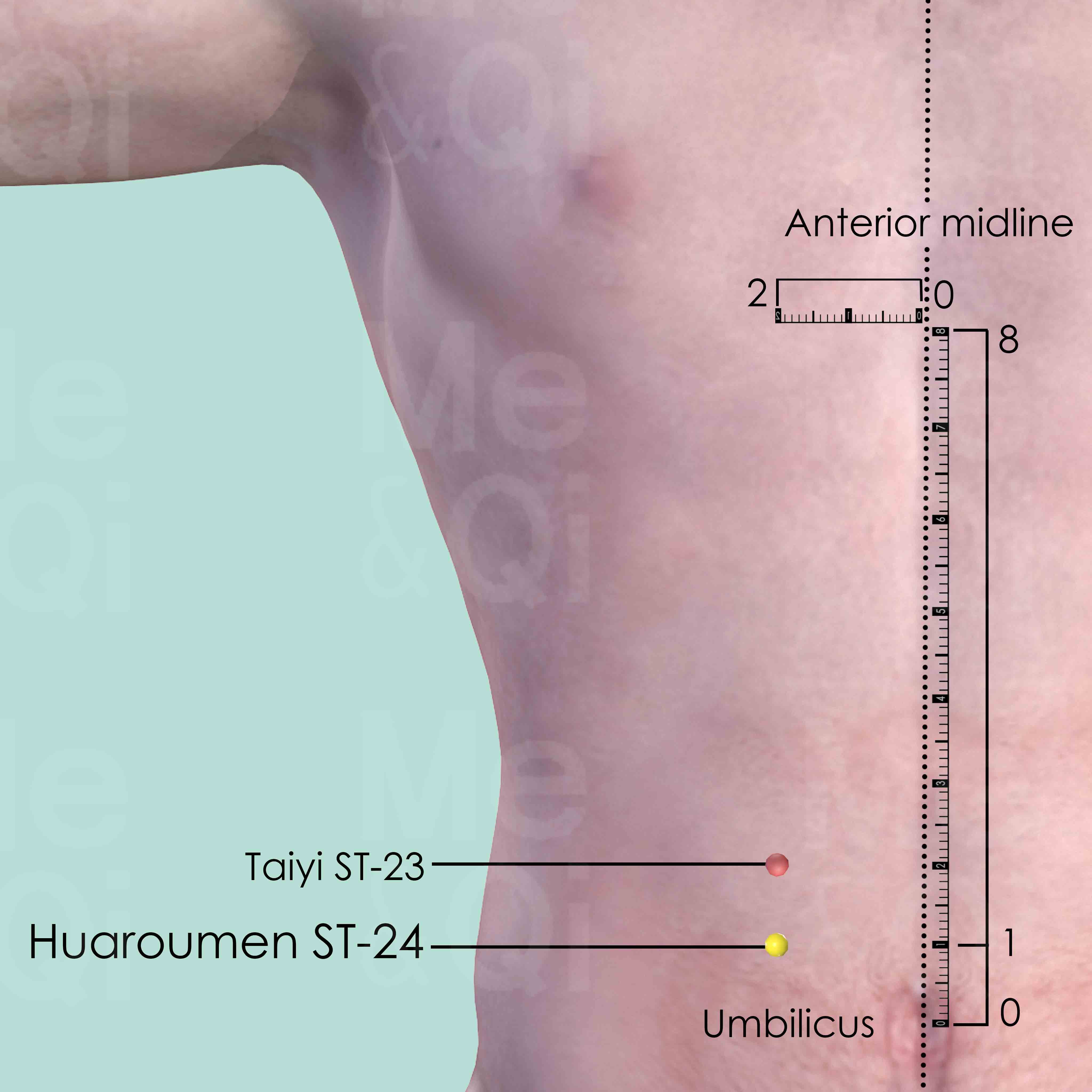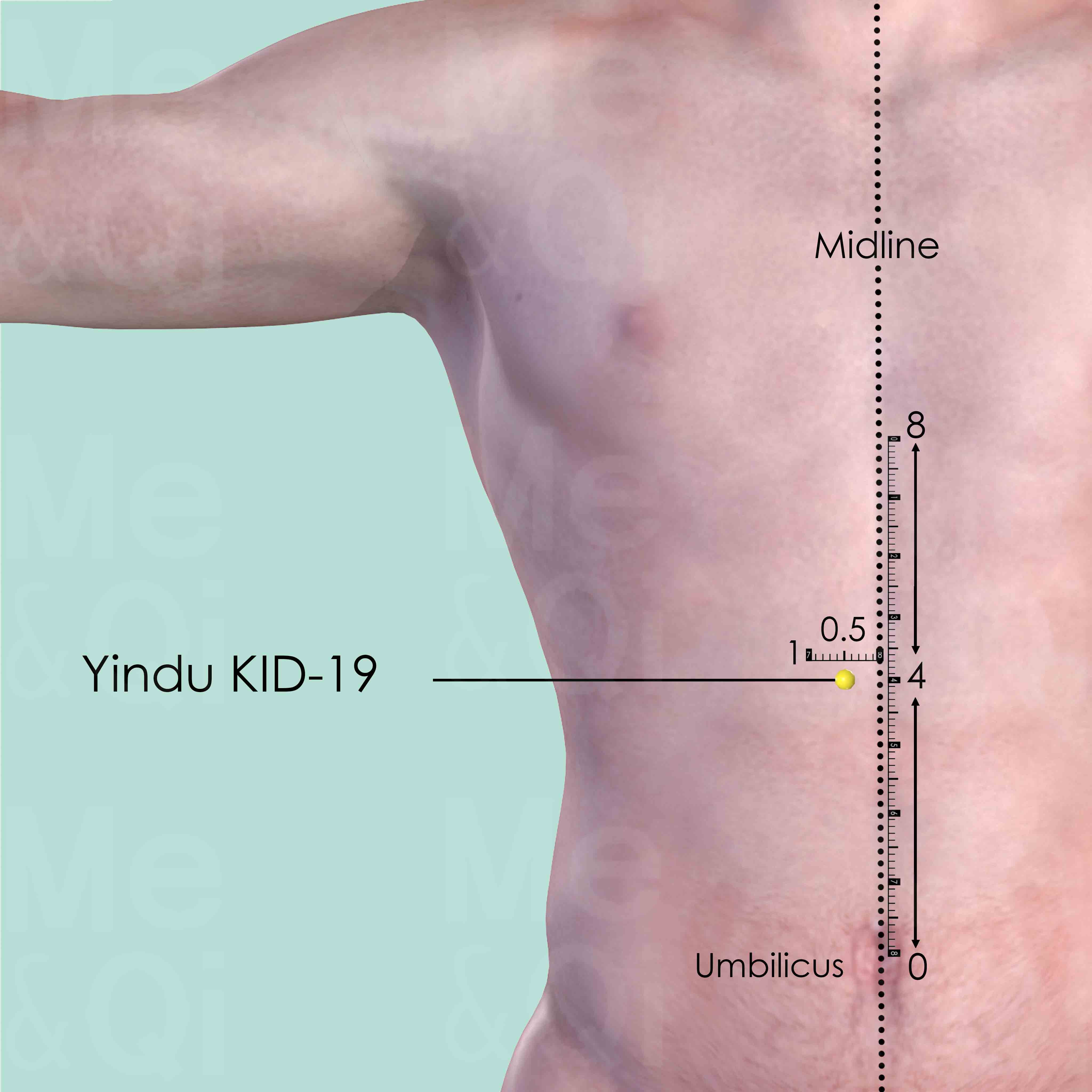Upper Abdominal Painaccording to TCM
Symptom families: General Abdominal Pain and Discomfort, Upper Abdominal Pain and Discomfort, Abdominal Distension and Fullness, Chest Discomfort & Sensations
Parent symptom: Abdominal Pain
Sub-symptom(s): Intermittent Upper Abdominal Pain Upper Abdominal Burning Pain Epigastric Pain Worsen By Pressure Epigastric Fullness And Pain Relieved By Vomiting Severe Upper Abdominal Pain
Did you mean? Chest Pain Upper Abdominal Fullness Stomach Pain
What is Upper Abdominal Pain?
Upper abdominal pain is a common symptom that affects the area above the navel, often reflecting disorders in the upper digestive tract. This discomfort can range from mild to severe and may manifest in various forms, such as epigastric pain, a burning sensation, or a sharp ache in the hypochondriac region. The pain may be intermittent, worsen with pressure, or sometimes alleviate with vomiting, indicating diverse underlying conditions.
How does TCM View Upper Abdominal Pain?
Traditional Chinese Medicine (TCM) interprets upper abdominal pain through the lens of Qi (energy) flow, organ health, and the balance of Yin and Yang. Unlike Western medicine, which often attributes pain to specific organ pathologies, TCM considers a broader spectrum of imbalances across the body's energy pathways.
Identifying the correct disharmony pattern is crucial for effective treatment, as TCM believes that each symptom, including pain, is a signal of an underlying imbalance.
Root Causes of Upper Abdominal Pain in TCM
TCM recognizes several patterns that can lead to upper abdominal pain, each associated with different symptoms and underlying imbalances. For example, Qi Stagnation, particularly Liver Qi Stagnation, can manifest as upper abdominal discomfort alongside emotional symptoms like irritability. Damp-Heat in the Stomach is another common cause, presenting with symptoms like nausea, fullness, and a feeling of heaviness.
Additionally, Phlegm accumulation, Qi Rebellion, and Yin Deficiency are recognized patterns, each contributing to the manifestation of pain in unique ways. Understanding these patterns is essential for tailoring the treatment to the individual's specific TCM diagnosis.
Explore below more details about what might cause Upper abdominal pain according to TCM.
- By Syndrome
- By Organ
- Heat
- Qi Stagnation
- Phlegm
- Dampness
- Qi Rebellion
- Yin Deficiency
- Blood Stasis
- Yin Excess
- Cold
- View More Causes
- Stomach
- Liver
- Gallbladder
- Kidney
- Lung
- Spleen
- View More Organs
Heat
In TCM "Heat" signifies an excess of Yang energy, leading to an imbalance where heat predominates over the body's cool Yin aspects. This condition is metaphorically akin to an internal over-heating. Symptoms indicative of Heat can include feelings of warmth, fever, sweating, irritability, red face, thirst with a preference for cold drinks, and a rapid pulse. The tongue may appear red with a yellow coating. Unlike the common interpretation of heat in terms of temperature, in TCM, it represents a state of hyperactivity or inflammation in the body.... see more
Heat Patterns That Can Lead to Upper Abdominal Pain
Common Symptoms: Feeling Hot Bitter Taste In The Mouth Upper Abdominal Fullness Feeling Of Heaviness Dry Mouth Without Desire To Drink Nausea Dull Yellow Complexion Sticky Taste In The Mouth
| Pattern Name | Relevant Symptoms | Relevant Formulas |
|---|---|---|
| Damp-Heat in the Stomach | Epigastric pain, Upper abdominal pain, Upper abdominal fullness, Feeling of heaviness, Face pain, Congested nose, Thick nasal discharge, Dry mouth without desire to drink, Nausea, Feeling hot, Dull yellow complexion, Sticky taste in the mouth... see more | Lian Po Yin | Ge Hua Jie Cheng San |
| Phlegm-Heat in the Lungs | Epigastric pain, Coughing, Shortness of breath, Wheezing, Stifling sensation in the chest, Sputum, Feeling hot, Thirst, Head and body heaviness, Dizziness, Copious thick yellow sputum... see more | Xiao Xian Xiong Tang |
| Damp-Heat invading the Spleen | Abdominal and epigastric pain, Lack of appetite, Feeling of heaviness, Dry mouth without desire to drink, Nausea or vomiting, Malodorous diarrhea, Anal burning, Feeling hot, Scanty and dark urine, Low grade fever, Dull headache, Dull yellow complexion, Yellow sclera, Oily sweat, Itchy rashes, Bitter taste in the mouth, Upper abdominal fullness, Upper abdominal pain... see more | Lian Po Yin |
| Heat in Lessor Yang | Burning abdominal pain, Fever, Bitter taste in the mouth, Abdominal pain, Diarrhea, Sticky taste in the mouth, Malodorous diarrhea, Anal irritation, Upper abdominal burning pain, Tenesmus... see more | Huang Qin Tang |
| Stomach Heat or Fire | Burning epigastric pain, Upper abdominal burning pain, Excessive thirst, Craving for cold beverages, Restlessness, Dry stools, Dry mouth, Mouth ulcers, Acid reflux, Nausea, Vomiting after eating, Excessive hunger, Bad breath, Feeling hot, Acne... see more | Tiao Wei Cheng Qi Tang | Qing Wei San | Xie Huang San | Fei Er Wan | Hua Ban Tang |
| Liver Qi Stagnation that transforms into Heat | Intermittent epigastric pain, Intermittent upper abdominal pain, Hernia-Related pain, Dysmenorrhea exacerbated by hot food or drinks, Irritability, Bitter taste in the mouth, Peptic ulcer, Chronic gastritis, Hepatitis, Cholecystitis... see more | Jin Ling Zi San |
Qi Stagnation
Qi Stagnation in TCM is like having a traffic jam in your body's energy system. Qi, the vital life force that flows through your body, is supposed to move smoothly to maintain health and balance. But with Qi Stagnation, this flow gets blocked or slowed down, like cars stuck on a highway. This can lead to symptoms like feeling stressed, emotional mood swings, and physical discomfort, often described as a feeling of fullness or tightness, especially in the chest or abdomen. It's as though the body's internal energy circulation is disrupted, causing various issues. TCM sees this as an energy flow problem, different from modern medicine's focus on specific physiological processes.... see more
Qi Stagnation Patterns That Can Lead to Upper Abdominal Pain
Common Symptoms: Irritability Upper Abdominal Distension Belching Nausea Vomit Hiccups Hepatitis Chronic Gastritis
| Pattern Name | Relevant Symptoms | Relevant Formulas |
|---|---|---|
| Stomach Qi Stagnation | Epigastric pain, Upper abdominal pain, Upper abdominal distension, Belching, Nausea, Vomit, Hiccups, Irritability... see more | Ban Xia Hou Pu Tang | Zuo Jin Wan |
| Liver Qi Stagnation | Epigastic pain, Hypochondriac distention, Chest distension, Upper abdominal distension, Abdominal distention, Sighing, Melancholia, Depression, Mood swings, Irregular periods, Globus sensation, Pre menstrual breast distension, Pre menstrual tension, Anxiety, Anger... see more | Xiao Yao San | Jia Wei Xiao Yao San | Yue Ju Wan | Chai Hu Shu Gan San | Yi Guan Jian |
| Liver Qi Stagnation that transforms into Heat | Intermittent epigastric pain, Intermittent upper abdominal pain, Hernia-Related pain, Dysmenorrhea exacerbated by hot food or drinks, Irritability, Bitter taste in the mouth, Peptic ulcer, Chronic gastritis, Hepatitis, Cholecystitis... see more | Jin Ling Zi San |
Phlegm
In TCM "Phlegm" as a pattern of disharmony is a complex concept that extends beyond the physical manifestation of mucus. It represents a pathological factor that can disrupt the flow of Qi (vital energy) and blood, leading to various health issues. Phlegm in TCM is seen as a sticky, turbid substance arising from the body's inability to metabolize fluids properly, often due to a dysfunction of the spleen. It's not only associated with respiratory problems like cough and congestion but also with systemic issues. Symptoms can include a feeling of heaviness, mental cloudiness, dizziness, and in some cases, the formation of lumps or masses. Phlegm can even be "invisible," contributing to emotional disturbances like depression or stress. ... see more
Phlegm Patterns That Can Lead to Upper Abdominal Pain
Common Symptoms: Frequent And Urgent Urination Urinary Dysfunction Hematuria Gallstones Kidney Stones Back Pain Abdominal Pain Coughing
| Pattern Name | Relevant Symptoms | Relevant Formulas |
|---|---|---|
| Phlegm in Kidneys or Gallbladder | Epigastric pain, Frequent and urgent urination, Urinary dysfunction, Hematuria | Si Ni San | Pai Shi Tang |
| Phlegm-Heat in the Lungs | Epigastric pain, Coughing, Shortness of breath, Wheezing, Stifling sensation in the chest, Sputum, Feeling hot, Thirst, Head and body heaviness, Dizziness, Copious thick yellow sputum... see more | Xiao Xian Xiong Tang |
Dampness
"Dampness" in TCM is a concept that describes a pattern of disharmony where the body accumulates excess moisture. Imagine the heavy, sticky feeling you get on a very humid day; that's similar to what dampness feels like internally. It can manifest as a sense of heaviness, bloating, sluggishness, or even a foggy mind. This condition is often thought to arise from environmental factors like living in a damp place, dietary habits that promote moisture in the body, or internal imbalances that hinder the body's ability to process fluids properly. In TCM, dampness can obstruct the normal flow of energy and fluids in the body, leading to various symptoms.... see more
Dampness Patterns That Can Lead to Upper Abdominal Pain
Common Symptoms: Upper Abdominal Fullness Feeling Of Heaviness Dry Mouth Without Desire To Drink Feeling Hot Dull Yellow Complexion Face Pain Congested Nose Thick Nasal Discharge
| Pattern Name | Relevant Symptoms | Relevant Formulas |
|---|---|---|
| Damp-Heat in the Stomach | Epigastric pain, Upper abdominal pain, Upper abdominal fullness, Feeling of heaviness, Face pain, Congested nose, Thick nasal discharge, Dry mouth without desire to drink, Nausea, Feeling hot, Dull yellow complexion, Sticky taste in the mouth... see more | Lian Po Yin | Ge Hua Jie Cheng San |
| Damp-Heat invading the Spleen | Abdominal and epigastric pain, Lack of appetite, Feeling of heaviness, Dry mouth without desire to drink, Nausea or vomiting, Malodorous diarrhea, Anal burning, Feeling hot, Scanty and dark urine, Low grade fever, Dull headache, Dull yellow complexion, Yellow sclera, Oily sweat, Itchy rashes, Bitter taste in the mouth, Upper abdominal fullness, Upper abdominal pain... see more | Lian Po Yin |
Qi Rebellion
Rebellious Qi in TCM is a bit like having a rebel inside your body. Qi, which is the vital energy flowing through your body, is supposed to move in certain directions to keep everything in balance and working well. But with Rebellious Qi, this energy decides to go the opposite way. Think of it like a river flowing upstream instead of downstream. This can cause various issues like heartburn, coughing, or even headaches. It's as if the body's natural flow is disrupted, creating a kind of internal chaos. TCM focuses on correcting this flow, restoring order and balance.... see more
Qi Rebellion Patterns That Can Lead to Upper Abdominal Pain
| Pattern Name | Relevant Symptoms | Relevant Formulas |
|---|---|---|
| Rebellious Liver Qi invading the Stomach | Epigastric pain, Irritability, Upper abdominal pain, Upper abdominal distension, Hypochondriac pain, Hypochondriac distention, Upper abdominal oppression, Acid reflux, Hiccups, Belching, Nausea or vomiting, Sighing, Weak limbs... see more | Xuan Fu Dai Zhe Tang | Ban Xia Hou Pu Tang | Si Mo Tang | Ju Pi Zhu Ru Tang | Ding Xiang Shi Di Tang |
Yin Deficiency
Yin deficiency in TCM is a pattern of disharmony characterized by a depletion of the body's Yin energy, which represents the cooling, moistening, and nurturing aspects of our physiology. This condition often arises from factors like chronic stress, overwork, insufficient rest, or prolonged illness. Symptoms of Yin deficiency can include a sensation of heat, especially in the afternoon or evening, night sweats, insomnia, a dry mouth or throat, and a red tongue with little coating. There might also be a general feeling of restlessness or irritability. Since Yin is essential for balancing the body's active and warm Yang energy, its deficiency leads to a relative excess of Yang, manifesting as heat or dryness symptoms.... see more
Yin Deficiency Patterns That Can Lead to Upper Abdominal Pain
| Pattern Name | Relevant Symptoms | Relevant Formulas |
|---|---|---|
| Stomach Yin Deficiency | Epigastric pain, Epigastic pain, Lack of appetite, Preference for sipping, Slight abdominal distension after eating... see more | Mai Men Dong Tang | Yi Wei Tang | Shen Ling Bai Zhu San |
Blood Stasis
Blood Stasis in TCM is a concept where the blood flow in the body is not as smooth or efficient as it should be. Imagine a river that's supposed to flow freely, but instead, it's getting blocked or moving too slowly in some parts. This can lead to various health issues, like pain that feels sharp or stabbing, dark bruises, and a complexion that looks purplish. TCM believes that good health relies on the smooth and vibrant flow of Qi and blood throughout the body, so when blood gets stuck, it's like a traffic jam in your body, leading to discomfort or health problems.... see more
Blood Stasis Patterns That Can Lead to Upper Abdominal Pain
| Pattern Name | Relevant Symptoms | Relevant Formulas |
|---|---|---|
| Stomach Blood Stagnation | Epigastric pain, Nocturnal epigastric pain, Abdominal pain worsened by pressure, Nausea or vomiting, Potential vomiting of blood, Hematochezia... see more | Xue Fu Zhu Yu Tang |
Yin Excess
Yin Excess in TCM is a pattern of disharmony characterized by an overabundance of Yin energy, leading to symptoms of dampness and coldness in the body. This condition often results from an imbalance where the cooling, moistening aspects of Yin overshadow the warm, active qualities of Yang energy. Symptoms can include a feeling of heaviness, lethargy, cold sensations, pale complexion, and possibly edema or fluid retention. Digestive issues such as poor appetite, bloating, and loose stools may also be present, reflecting the impact of excess Yin on the body's metabolic processes. Treatment in TCM for Yin Excess focuses on reducing the excess Yin and stimulating Yang energy to restore balance. ... see more
Yin Excess Patterns That Can Lead to Upper Abdominal Pain
| Pattern Name | Relevant Symptoms | Relevant Formulas |
|---|---|---|
| Yin Excess | Epigastric pain worsen by pressure, Absence of thirst, Slow and forceful movement, Polyuria, Feeling of oppression of the chest, Nausea, Excessive vaginal discharge, Lack of appetite, Pain relieved by heat, Chills, Cold extremities, Pale urine... see more | Wu Ling San | Wu Pi Yin |
Cold
In TCM "Cold" as a pattern of disharmony refers to a specific type of imbalance within the body's systems, often linked to a deficiency or weakness. It's not about feeling physically cold or having a common cold, but rather a metaphorical description of certain symptoms and underlying conditions. When a TCM practitioner says someone suffers from "Cold," it usually implies that the body's Yang energy, which is warm and active, is insufficient or overpowered by Yin energy, which is cool and passive. Symptoms of Cold in TCM can include a general feeling of coldness, cold limbs, pale complexion, low energy, slow metabolism, and a preference for warmth. ... see more
Cold Patterns That Can Lead to Upper Abdominal Pain
| Pattern Name | Relevant Symptoms | Relevant Formulas |
|---|---|---|
| Cold invading the Stomach | Severe epigastric pain, Severe upper abdominal pain, Chills, Cold extremities, Desire for hot beverages and foods, Vomiting clear liquid, Nausea, Deterioration after cold beverages... see more | Liang Fu Wan | Huo Xiang Zheng Qi San | Wu Zhu Yu Tang |
Stomach
In TCM the Stomach is regarded as the "sea of nourishment," pivotal for digesting food and transforming it into Qi and blood. It works closely with the Spleen to distribute these essential nutrients throughout the body. When the Stomach is out of balance or malfunctions in TCM, it often leads to digestive problems such as bloating, nausea, vomiting, poor appetite, or a feeling of fullness. There may also be issues like acid reflux or a sour taste in the mouth. Emotionally, an imbalanced Stomach can contribute to excessive worry and overthinking, reflecting the TCM belief that physical and emotional well-being are deeply interconnected.... see more
Stomach Patterns That Can Lead to Upper Abdominal Pain
Common Symptoms: Nausea Irritability Acid Reflux Hiccups Belching Feeling Hot Upper Abdominal Distension Nausea Or Vomiting
| Pattern Name | Relevant Symptoms | Relevant Formulas |
|---|---|---|
| Damp-Heat in the Stomach | Epigastric pain, Upper abdominal pain, Upper abdominal fullness, Feeling of heaviness, Face pain, Congested nose, Thick nasal discharge, Dry mouth without desire to drink, Nausea, Feeling hot, Dull yellow complexion, Sticky taste in the mouth... see more | Lian Po Yin | Ge Hua Jie Cheng San |
| Rebellious Liver Qi invading the Stomach | Epigastric pain, Irritability, Upper abdominal pain, Upper abdominal distension, Hypochondriac pain, Hypochondriac distention, Upper abdominal oppression, Acid reflux, Hiccups, Belching, Nausea or vomiting, Sighing, Weak limbs... see more | Xuan Fu Dai Zhe Tang | Ban Xia Hou Pu Tang | Si Mo Tang | Ju Pi Zhu Ru Tang | Ding Xiang Shi Di Tang |
| Stomach Qi Stagnation | Epigastric pain, Upper abdominal pain, Upper abdominal distension, Belching, Nausea, Vomit, Hiccups, Irritability... see more | Ban Xia Hou Pu Tang | Zuo Jin Wan |
| Stomach Yin Deficiency | Epigastric pain, Epigastic pain, Lack of appetite, Preference for sipping, Slight abdominal distension after eating... see more | Mai Men Dong Tang | Yi Wei Tang | Shen Ling Bai Zhu San |
| Stomach Blood Stagnation | Epigastric pain, Nocturnal epigastric pain, Abdominal pain worsened by pressure, Nausea or vomiting, Potential vomiting of blood, Hematochezia... see more | Xue Fu Zhu Yu Tang |
| Stomach Heat or Fire | Burning epigastric pain, Upper abdominal burning pain, Excessive thirst, Craving for cold beverages, Restlessness, Dry stools, Dry mouth, Mouth ulcers, Acid reflux, Nausea, Vomiting after eating, Excessive hunger, Bad breath, Feeling hot, Acne... see more | Tiao Wei Cheng Qi Tang | Qing Wei San | Xie Huang San | Fei Er Wan | Hua Ban Tang |
| Food Stagnation in the Stomach | Fullness and pain of the epigastrium which are relieved by vomiting, Epigastric fullness and pain relieved by vomiting, Nausea, Vomiting of sour fluids, Bad breath, Acid reflux, Belching, Insomnia, Alternating diarrhea and constipation, Lack of appetite, Abdominal pain due to overeating... see more | Bao He Wan | Zhi Shi Dao Zhi Wan | Gua Di San |
| Cold invading the Stomach | Severe epigastric pain, Severe upper abdominal pain, Chills, Cold extremities, Desire for hot beverages and foods, Vomiting clear liquid, Nausea, Deterioration after cold beverages... see more | Liang Fu Wan | Huo Xiang Zheng Qi San | Wu Zhu Yu Tang |
Liver
In TCM the Liver is viewed as the organ responsible for the smooth flow of Qi, Blood, and emotions throughout the body. It plays a key role in regulating mood, storing blood, supporting digestion, and ensuring the health of tendons and eyes. When the Liver malfunctions or is imbalanced in TCM, it can lead to a range of issues such as irritability, mood swings, menstrual irregularities, eye problems, and muscular stiffness or pain. A malfunctioning Liver in TCM reflects not only physical disturbances but also emotional and mental disharmony, emphasizing the holistic approach of TCM in addressing health and wellness.... see more
Liver Patterns That Can Lead to Upper Abdominal Pain
Common Symptoms: Irritability Upper Abdominal Distension Hypochondriac Pain Hypochondriac Distention Hiccups Belching Sighing Hepatitis
| Pattern Name | Relevant Symptoms | Relevant Formulas |
|---|---|---|
| Rebellious Liver Qi invading the Stomach | Epigastric pain, Irritability, Upper abdominal pain, Upper abdominal distension, Hypochondriac pain, Hypochondriac distention, Upper abdominal oppression, Acid reflux, Hiccups, Belching, Nausea or vomiting, Sighing, Weak limbs... see more | Xuan Fu Dai Zhe Tang | Ban Xia Hou Pu Tang | Si Mo Tang | Ju Pi Zhu Ru Tang | Ding Xiang Shi Di Tang |
| Liver Qi Stagnation | Epigastic pain, Hypochondriac distention, Chest distension, Upper abdominal distension, Abdominal distention, Sighing, Melancholia, Depression, Mood swings, Irregular periods, Globus sensation, Pre menstrual breast distension, Pre menstrual tension, Anxiety, Anger... see more | Xiao Yao San | Jia Wei Xiao Yao San | Yue Ju Wan | Chai Hu Shu Gan San | Yi Guan Jian |
| Liver Qi Stagnation that transforms into Heat | Intermittent epigastric pain, Intermittent upper abdominal pain, Hernia-Related pain, Dysmenorrhea exacerbated by hot food or drinks, Irritability, Bitter taste in the mouth, Peptic ulcer, Chronic gastritis, Hepatitis, Cholecystitis... see more | Jin Ling Zi San |
Gallbladder
In TCM the Gallbladder has a unique role in storing and excreting bile, but more importantly, it's seen as crucial for decision-making and courage. It's closely connected to the Liver, assisting in the smooth flow of Qi (vital energy) and supporting the Liver's role in maintaining emotional balance. When the Gallbladder malfunctions or is imbalanced in TCM, it can lead to physical symptoms like gallstones, jaundice, or a bitter taste in the mouth. There might also be digestive disturbances, particularly related to fat metabolism. On an emotional level, a Gallbladder disorder can manifest as indecisiveness, timidity, or a tendency to easily succumb to stress. These symptoms highlight the TCM view of the Gallbladder as integral to both physical processes and emotional resilience.... see more
Gallbladder Patterns That Can Lead to Upper Abdominal Pain
| Pattern Name | Relevant Symptoms | Relevant Formulas |
|---|---|---|
| Phlegm in Kidneys or Gallbladder | Epigastric pain, Frequent and urgent urination, Urinary dysfunction, Hematuria | Si Ni San | Pai Shi Tang |
Kidney
In TCM the Kidneys are regarded as the body's most fundamental reservoir of Essence, known as Jing, which influences growth, reproduction, and aging. They are not just organs for filtering blood, but a holistic system governing vital life forces. When the Kidneys malfunction in TCM, it can manifest as a variety of health issues, such as chronic fatigue, reproductive problems, imbalances in fluid metabolism leading to edema or dryness, lower back pain, and a sense of fear or insecurity.... see more
Kidney Patterns That Can Lead to Upper Abdominal Pain
| Pattern Name | Relevant Symptoms | Relevant Formulas |
|---|---|---|
| Phlegm in Kidneys or Gallbladder | Epigastric pain, Frequent and urgent urination, Urinary dysfunction, Hematuria | Si Ni San | Pai Shi Tang |
Lung
In TCM the Lungs are seen as the organ responsible for controlling Qi and respiration, as well as being a key part of the body's defensive system. They are thought to maintain the balance and flow of air and moisture, and are closely linked to the skin and hair. When the Lungs are imbalanced or malfunctioning in TCM, it can lead to respiratory issues like coughing or asthma, a weakened immune system, dry skin, and emotional disturbances such as sadness or grief. These symptoms are believed to arise from disruptions in the Lungs' ability to regulate Qi and protect the body, highlighting their central role in maintaining overall health and well-being.... see more
Lung Patterns That Can Lead to Upper Abdominal Pain
| Pattern Name | Relevant Symptoms | Relevant Formulas |
|---|---|---|
| Phlegm-Heat in the Lungs | Epigastric pain, Coughing, Shortness of breath, Wheezing, Stifling sensation in the chest, Sputum, Feeling hot, Thirst, Head and body heaviness, Dizziness, Copious thick yellow sputum... see more | Xiao Xian Xiong Tang |
Spleen
In TCM the Spleen plays a vital role in digestion and transformation, converting food into energy and nutrients, and overseeing the distribution of Qi and Blood. It's also crucial in maintaining the health of muscles and limbs and ensuring the blood remains within the vessels. When the Spleen malfunctions in TCM, it can lead to a variety of issues such as digestive disorders, fatigue, weak muscles, bloating, and a feeling of heaviness. It can also cause a pale complexion, poor appetite, and a tendency to bruise easily. Emotionally, a Spleen imbalance is often associated with excessive worry or overthinking, reflecting its role in the interplay between physical and mental health.... see more
Spleen Patterns That Can Lead to Upper Abdominal Pain
| Pattern Name | Relevant Symptoms | Relevant Formulas |
|---|---|---|
| Damp-Heat invading the Spleen | Abdominal and epigastric pain, Lack of appetite, Feeling of heaviness, Dry mouth without desire to drink, Nausea or vomiting, Malodorous diarrhea, Anal burning, Feeling hot, Scanty and dark urine, Low grade fever, Dull headache, Dull yellow complexion, Yellow sclera, Oily sweat, Itchy rashes, Bitter taste in the mouth, Upper abdominal fullness, Upper abdominal pain... see more | Lian Po Yin |
TCM Herbal Formulas for Upper Abdominal Pain
To address upper abdominal pain, TCM utilizes a variety of herbal formulas, each suited to counteract specific disharmonies. For Damp-Heat in the Stomach, formulas like Lian Po Yin, containing Huang Lian, work to clear Heat and expel Dampness. Phlegm-related discomfort might be treated with Si Ni San, which harmonizes the Liver-Spleen relationship.
For Qi Stagnation, Ban Xia Hou Pu Tang and Xiao Yao San are commonly prescribed to promote Qi movement and alleviate pain. When dealing with Rebellious Liver Qi affecting the Stomach, Xuan Fu Dai Zhe Tang offers relief by directing rebellious Qi downward. In cases of Stomach Yin Deficiency, Mai Men Dong Tang nourishes Yin and moistens Dryness, addressing the root cause of the pain.
Explore below some TCM herbal formulas used to address upper abdominal pain, organized by cause and by formula type.
- By Cause
- By Formula Type
- Heat
- Qi Stagnation
- Phlegm
- Dampness
- Qi Rebellion
- Yin Deficiency
- Blood Stasis
- Yin Excess
- Cold
- View More Causes
- Formulas that promote qi movement
- Formulas that harmonize liver-Spleen
- Formulas for a rebellious qi
- Formulas that clear heat from the organs
- Formulas that reduce food accumulation and transform stagnation
- Formulas that clear heat and expel dampness
- Formulas that invigorate blood and dispel blood stagnation
- Formulas that nourish yin and tonify
- Formulas that promote urination and leach out dampness
- Formulas that reduce food stagnation with tonification
- Formulas that clear heat
- Formulas that enrich yin and moisten dryness
- Formulas that tonify qi
- Formulas that clear heat and transform phlegm
- Formulas that purge heat accumulation
- Formulas that clear heat from qi and blood
- Formulas that induce vomiting
- Formulas that transform dampness and harmonize stomach
- Formulas that warm the middle and dispel cold
Top Formula for Heat:
Lian Po Yin
Suitable for Heat patterns that may cause upper abdominal pain, such as Damp-Heat in the Stomach or Damp-Heat invading the Spleen
Learn moreAll Formulas Recommended for Upper Abdominal Pain Caused by Heat
| Formula | Patterns Suitable For |
|---|---|
| Lian Po Yin | Damp-Heat in the Stomach, Damp-Heat invading the Spleen |
| Ge Hua Jie Cheng San | Damp-Heat in the Stomach |
| Xiao Xian Xiong Tang | Phlegm-Heat in the Lungs |
| Jin Ling Zi San | Liver Qi Stagnation that transforms into Heat |
| Huang Qin Tang | Heat in Lessor Yang |
| Tiao Wei Cheng Qi Tang | Stomach Heat or Fire |
| Qing Wei San | Stomach Heat or Fire |
| Xie Huang San | Stomach Heat or Fire |
| Fei Er Wan | Stomach Heat or Fire |
| Hua Ban Tang | Stomach Heat or Fire |
Top Formula for Qi Stagnation:
Ban Xia Hou Pu Tang
Suitable for Qi Stagnation patterns that may cause upper abdominal pain, such as Stomach Qi Stagnation
Learn moreAll Formulas Recommended for Upper Abdominal Pain Caused by Qi Stagnation
| Formula | Patterns Suitable For |
|---|---|
| Ban Xia Hou Pu Tang | Stomach Qi Stagnation |
| Zuo Jin Wan | Stomach Qi Stagnation |
| Xiao Yao San | Liver Qi Stagnation |
| Jia Wei Xiao Yao San | Liver Qi Stagnation |
| Yue Ju Wan | Liver Qi Stagnation |
| Chai Hu Shu Gan San | Liver Qi Stagnation |
| Yi Guan Jian | Liver Qi Stagnation |
| Jin Ling Zi San | Liver Qi Stagnation that transforms into Heat |
Top Formula for Phlegm:
Si Ni San
Suitable for Phlegm patterns that may cause upper abdominal pain, such as Phlegm in Kidneys or Gallbladder
Learn moreAll Formulas Recommended for Upper Abdominal Pain Caused by Phlegm
| Formula | Patterns Suitable For |
|---|---|
| Si Ni San | Phlegm in Kidneys or Gallbladder |
| Pai Shi Tang | Phlegm in Kidneys or Gallbladder |
| Xiao Xian Xiong Tang | Phlegm-Heat in the Lungs |
Top Formula for Dampness:
Lian Po Yin
Suitable for Dampness patterns that may cause upper abdominal pain, such as Damp-Heat in the Stomach or Damp-Heat invading the Spleen
Learn moreAll Formulas Recommended for Upper Abdominal Pain Caused by Dampness
| Formula | Patterns Suitable For |
|---|---|
| Lian Po Yin | Damp-Heat in the Stomach, Damp-Heat invading the Spleen |
| Ge Hua Jie Cheng San | Damp-Heat in the Stomach |
Top Formula for Qi Rebellion:
Ban Xia Hou Pu Tang
Suitable for Qi Rebellion patterns that may cause upper abdominal pain, such as Rebellious Liver Qi invading the Stomach
Learn moreAll Formulas Recommended for Upper Abdominal Pain Caused by Qi Rebellion
| Formula | Patterns Suitable For |
|---|---|
| Ban Xia Hou Pu Tang | Rebellious Liver Qi invading the Stomach |
| Xuan Fu Dai Zhe Tang | Rebellious Liver Qi invading the Stomach |
| Si Mo Tang | Rebellious Liver Qi invading the Stomach |
| Ju Pi Zhu Ru Tang | Rebellious Liver Qi invading the Stomach |
| Ding Xiang Shi Di Tang | Rebellious Liver Qi invading the Stomach |
Top Formula for Yin Deficiency:
Mai Men Dong Tang
Suitable for Yin Deficiency patterns that may cause upper abdominal pain, such as Stomach Yin Deficiency
Learn moreAll Formulas Recommended for Upper Abdominal Pain Caused by Yin Deficiency
| Formula | Patterns Suitable For |
|---|---|
| Mai Men Dong Tang | Stomach Yin Deficiency |
| Yi Wei Tang | Stomach Yin Deficiency |
| Shen Ling Bai Zhu San | Stomach Yin Deficiency |
Top Formula for Blood Stasis:
Xue Fu Zhu Yu Tang
Suitable for Blood Stasis patterns that may cause upper abdominal pain, such as Stomach Blood Stagnation
Learn moreTop Formula for Yin Excess:
Wu Ling San
Suitable for Yin Excess patterns that may cause upper abdominal pain, such as Yin Excess
Learn moreAll Formulas Recommended for Upper Abdominal Pain Caused by Yin Excess
| Formula | Patterns Suitable For |
|---|---|
| Wu Ling San | Yin Excess |
| Wu Pi Yin | Yin Excess |
Top Formula for Cold:
Liang Fu Wan
Suitable for Cold patterns that may cause upper abdominal pain, such as Cold invading the Stomach
Learn moreAll Formulas Recommended for Upper Abdominal Pain Caused by Cold
| Formula | Patterns Suitable For |
|---|---|
| Liang Fu Wan | Cold invading the Stomach |
| Huo Xiang Zheng Qi San | Cold invading the Stomach |
| Wu Zhu Yu Tang | Cold invading the Stomach |
Formulas that promote Qi movement
These formulas are suitable for some upper abdominal pain-causing patterns like Rebellious Liver Qi invading the Stomach or Stomach Qi Stagnation.
One such formula is Ban Xia Hou Pu Tang, with crow-dipper rhizome as a key herb.
Other formulas of this category are listed in the table below.
All "formulas that promote qi movement" recommended for upper abdominal pain
| Formula | Patterns Suitable For (if applicable) |
|---|---|
| Ban Xia Hou Pu Tang | Rebellious Liver Qi invading the Stomach, Stomach Qi Stagnation |
| Si Mo Tang | Rebellious Liver Qi invading the Stomach |
| Yue Ju Wan | Liver Qi Stagnation |
| Chai Hu Shu Gan San | Liver Qi Stagnation |
| Jin Ling Zi San | Liver Qi Stagnation that transforms into Heat |
| Liang Fu Wan | Cold invading the Stomach |
Formulas that clear Heat and expel dampness
These formulas are suitable for some upper abdominal pain-causing patterns like Damp-Heat in the Stomach or Damp-Heat invading the Spleen.
One such formula is Lian Po Yin, with goldthread rhizome as a key herb.
Other formulas of this category are listed in the table below.
All "formulas that clear heat and expel dampness" recommended for upper abdominal pain
| Formula | Patterns Suitable For (if applicable) |
|---|---|
| Lian Po Yin | Damp-Heat in the Stomach, Damp-Heat invading the Spleen |
| Pai Shi Tang | Phlegm in Kidneys or Gallbladder |
Formulas that harmonize Liver-Spleen
These formulas are suitable for some upper abdominal pain-causing patterns like Phlegm in Kidneys or Gallbladder.
One such formula is Si Ni San, with bupleurum root as a key herb.
Other formulas of this category are listed in the table below.
All "formulas that harmonize liver-Spleen" recommended for upper abdominal pain
| Formula | Patterns Suitable For (if applicable) |
|---|---|
| Si Ni San | Phlegm in Kidneys or Gallbladder |
| Xiao Yao San | Liver Qi Stagnation |
| Jia Wei Xiao Yao San | Liver Qi Stagnation |
Formulas that clear Heat from the Organs
These formulas are suitable for some upper abdominal pain-causing patterns like Heat in Lessor Yang.
One such formula is Huang Qin Tang, with baikal skullcap root as a key herb.
Other formulas of this category are listed in the table below.
All "formulas that clear heat from the organs" recommended for upper abdominal pain
| Formula | Patterns Suitable For (if applicable) |
|---|---|
| Huang Qin Tang | Heat in Lessor Yang |
| Qing Wei San | Stomach Heat or Fire |
| Xie Huang San | Stomach Heat or Fire |
Formulas that reduce food accumulation and transform Stagnation
These formulas are suitable for some upper abdominal pain-causing patterns like Stomach Heat or Fire.
One such formula is Fei Er Wan, with quisqualis fruit as a key herb.
Other formulas of this category are listed in the table below.
All "formulas that reduce food accumulation and transform stagnation" recommended for upper abdominal pain
| Formula | Patterns Suitable For (if applicable) |
|---|---|
| Fei Er Wan | Stomach Heat or Fire |
| Bao He Wan | Food Stagnation in the Stomach |
| Zhi Shi Dao Zhi Wan | Food Stagnation in the Stomach |
Formulas that nourish Yin and tonify
These formulas are suitable for some upper abdominal pain-causing patterns like Stomach Yin Deficiency.
One such formula is Yi Wei Tang, with unprepared rehmannia as a key herb.
Other formulas of this category are listed in the table below.
All "formulas that nourish yin and tonify" recommended for upper abdominal pain
| Formula | Patterns Suitable For (if applicable) |
|---|---|
| Yi Wei Tang | Stomach Yin Deficiency |
| Yi Guan Jian | Liver Qi Stagnation |
Formulas for a rebellious Qi
These formulas are suitable for some upper abdominal pain-causing patterns like Rebellious Liver Qi invading the Stomach.
One such formula is Xuan Fu Dai Zhe Tang, with inula flower as a key herb.
Other formulas of this category are listed in the table below.
All "formulas for a rebellious qi" recommended for upper abdominal pain
| Formula | Patterns Suitable For (if applicable) |
|---|---|
| Xuan Fu Dai Zhe Tang | Rebellious Liver Qi invading the Stomach |
| Ju Pi Zhu Ru Tang | Rebellious Liver Qi invading the Stomach |
| Ding Xiang Shi Di Tang | Rebellious Liver Qi invading the Stomach |
Formulas that invigorate Blood and dispel Blood Stagnation
These formulas are suitable for some upper abdominal pain-causing patterns like Stomach Blood Stagnation.
One such formula is Xue Fu Zhu Yu Tang, with peach kernel as a key herb.
Other formulas of this category are listed in the table below.
All "formulas that invigorate blood and dispel blood stagnation" recommended for upper abdominal pain
| Formula | Patterns Suitable For (if applicable) |
|---|---|
| Xue Fu Zhu Yu Tang | Stomach Blood Stagnation |
| Shi Xiao San | Not applicable |
Formulas that promote urination and leach out Dampness
These formulas are suitable for some upper abdominal pain-causing patterns like Yin Excess.
One such formula is Wu Ling San, with water plantain as a key herb.
Other formulas of this category are listed in the table below.
All "formulas that promote urination and leach out dampness" recommended for upper abdominal pain
| Formula | Patterns Suitable For (if applicable) |
|---|---|
| Wu Ling San | Yin Excess |
| Wu Pi Yin | Yin Excess |
Formulas that reduce food Stagnation with tonification
These formulas are suitable for some upper abdominal pain-causing patterns like Damp-Heat in the Stomach.
One such formula is Ge Hua Jie Cheng San, with kudzu flower as a key herb.
Formulas that clear Heat
These formulas are suitable for some upper abdominal pain-causing patterns like Stomach Qi Stagnation.
One such formula is Zuo Jin Wan, with goldthread rhizome as a key herb.
Formulas that enrich Yin and moisten Dryness
These formulas are suitable for some upper abdominal pain-causing patterns like Stomach Yin Deficiency.
One such formula is Mai Men Dong Tang, with dwarf lilyturf root as a key herb.
Formulas that tonify Qi
These formulas are suitable for some upper abdominal pain-causing patterns like Stomach Yin Deficiency.
One such formula is Shen Ling Bai Zhu San, with ginseng as a key herb.
Formulas that clear Heat and transform Phlegm
These formulas are suitable for some upper abdominal pain-causing patterns like Phlegm-Heat in the Lungs.
One such formula is Xiao Xian Xiong Tang, with snake gourd as a key herb.
Formulas that purge Heat accumulation
These formulas are suitable for some upper abdominal pain-causing patterns like Stomach Heat or Fire.
One such formula is Tiao Wei Cheng Qi Tang, with rhubarb as a key herb.
Formulas that clear Heat from Qi and Blood
These formulas are suitable for some upper abdominal pain-causing patterns like Stomach Heat or Fire.
One such formula is Hua Ban Tang, with gypsum as a key herb.
Formulas that induce vomiting
These formulas are suitable for some upper abdominal pain-causing patterns like Food Stagnation in the Stomach.
One such formula is Gua Di San, with melon stalk as a key herb.
Formulas that transform Dampness and harmonize Stomach
These formulas are suitable for some upper abdominal pain-causing patterns like Cold invading the Stomach.
One such formula is Huo Xiang Zheng Qi San, with korean mint as a key herb.
Formulas that warm the middle and dispel Cold
These formulas are suitable for some upper abdominal pain-causing patterns like Cold invading the Stomach.
One such formula is Wu Zhu Yu Tang, with evodia fruit as a key herb.
Acupoints for Upper Abdominal Pain
TCM also incorporates acupuncture as a method to relieve upper abdominal pain. Specific acupoints like Burong ST-19 and Chengman ST-20 are targeted to harmonize the Middle Burner and subdue rebellious Qi. Points along the Stomach, Pericardium, Bladder, Spleen, and Directing Vessel, such as Neiguan P-6 and Zhongwan REN-12, are selected based on their ability to regulate Qi, invigorate Blood, clear Heat, and resolve Dampness, providing a holistic approach to alleviating pain and restoring balance within the body's energy system.
Explore below some acupoints used to address upper abdominal pain, organized by meridian.
- By Meridian
- Stomach Channel
- Pericardium Channel
- Bladder Channel
- Spleen Channel
- Directing Vessel
- Large Intestine Channel
- Liver Channel
- Gall Bladder Channel
- Extra Points: Back (EX-B)
- Kidney Channel
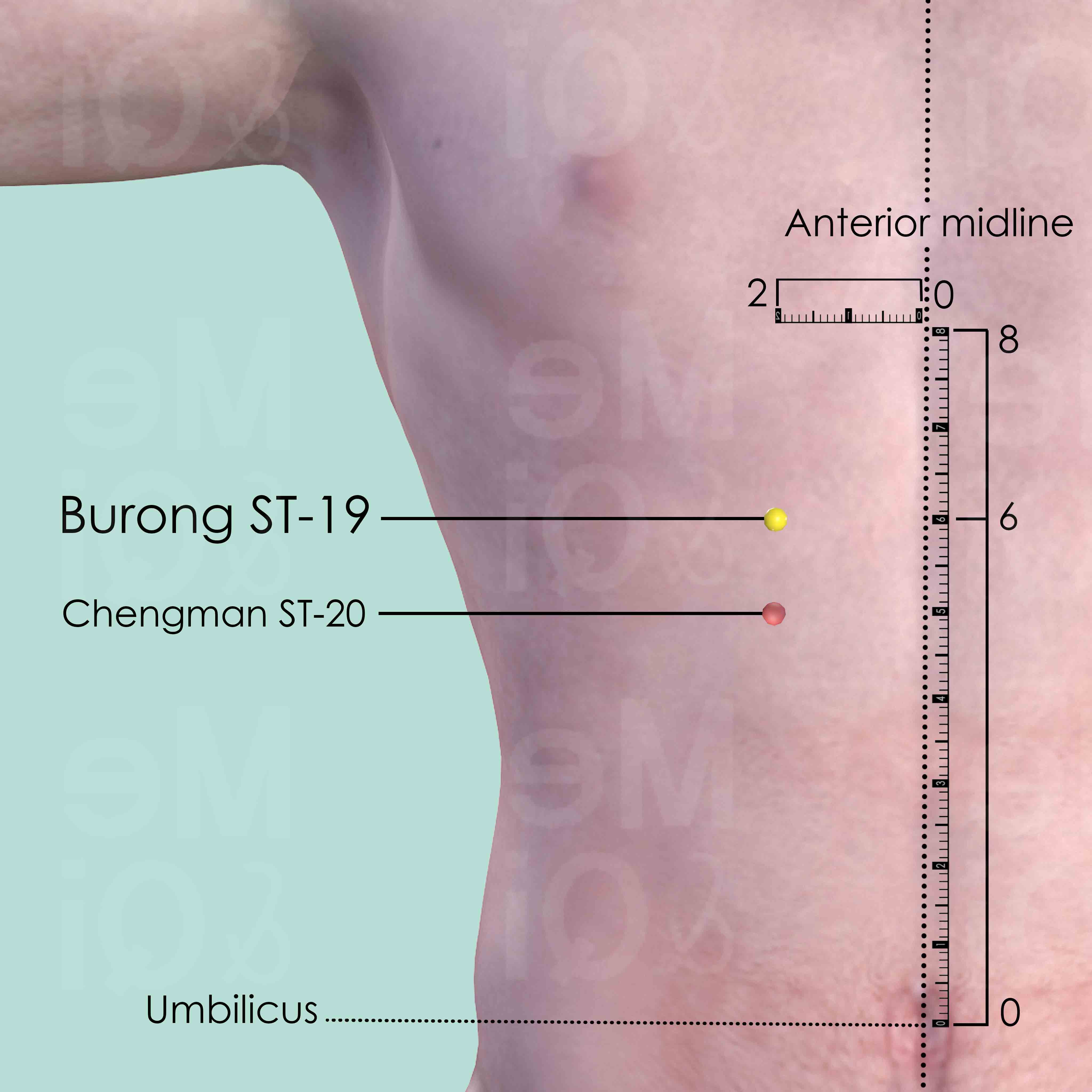
Burong ST-19
2 cun below the sternocostal angel and 6 cun above the umbilicus, 2 cun lateral to the anterior midline.
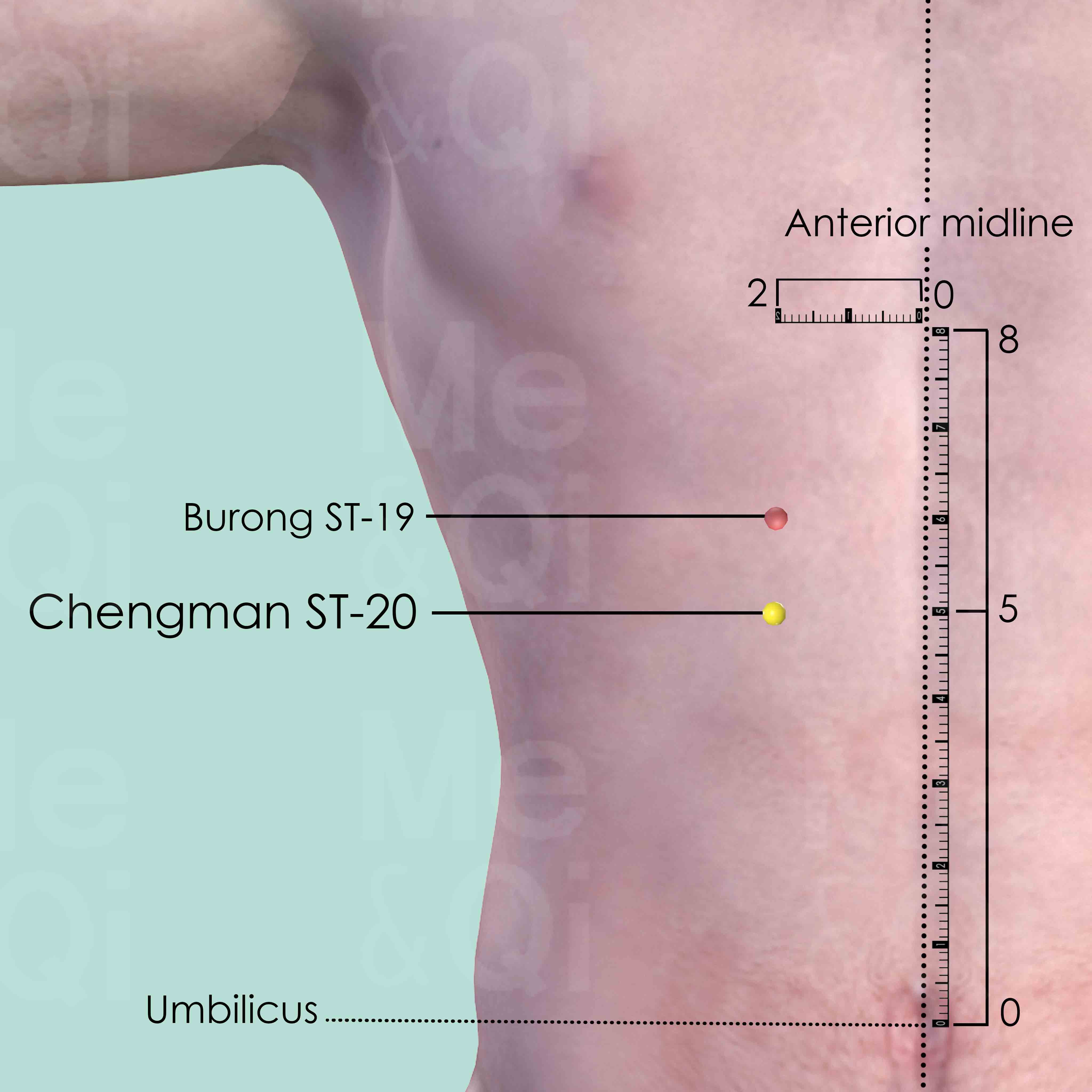
Chengman ST-20
5 cun above the umbilicus and 2 cun lateral to the anterior midline, or 1 cun below Burong ST-19.
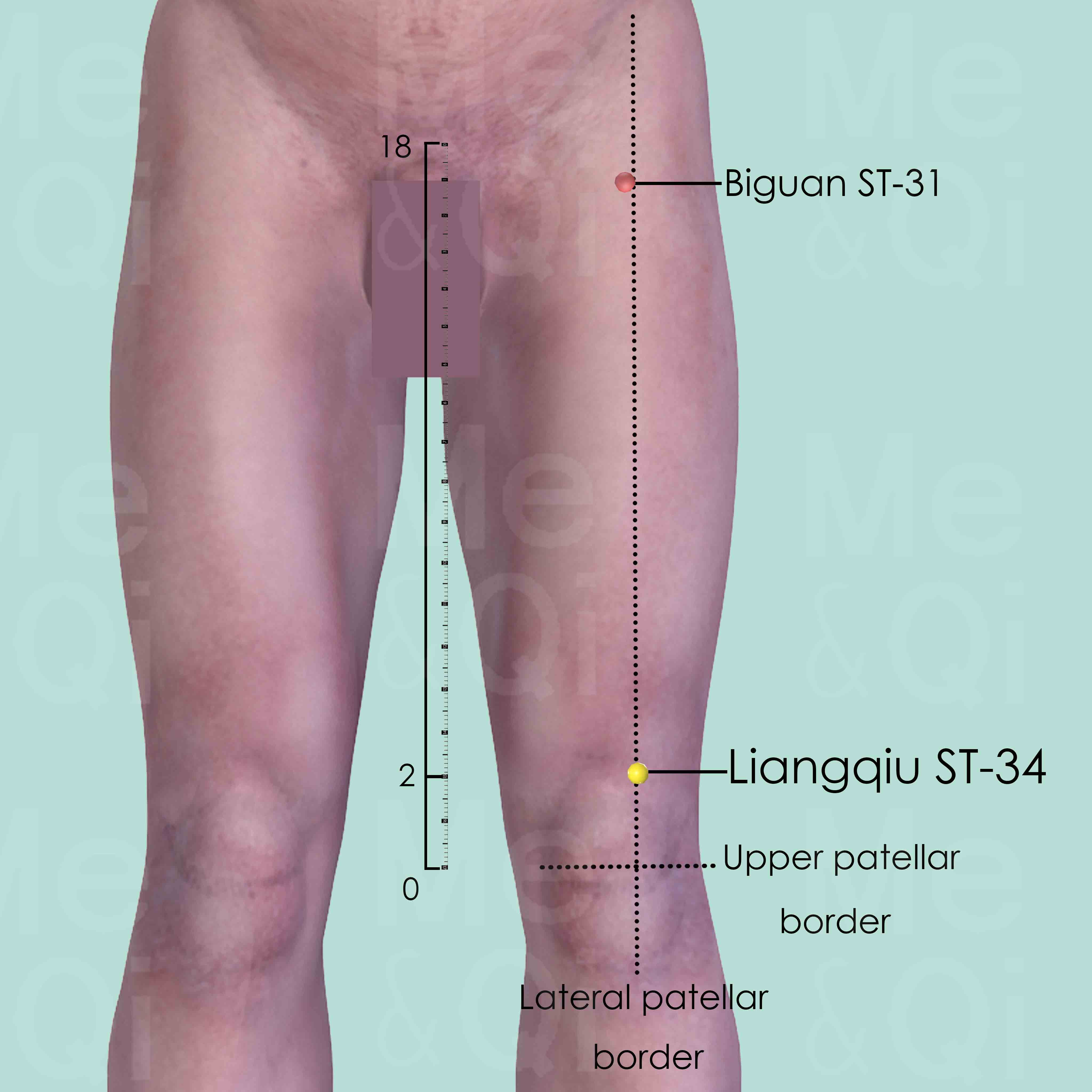
Liangqiu ST-34
2 cun above the upper-lateral border of the patella, on a line between the upper lateral patellar border and the anterior superior iliac spine (ASIS).
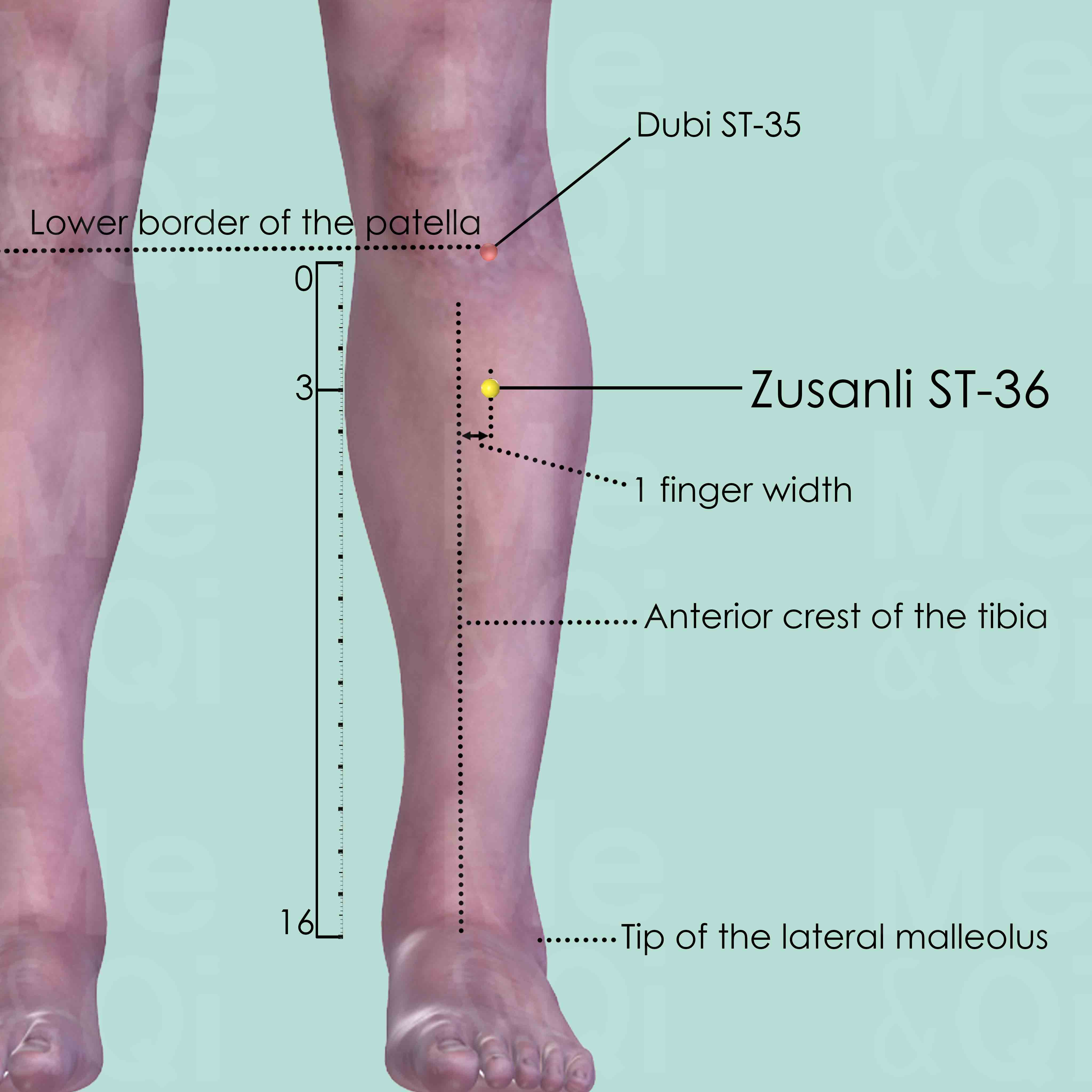
Zusanli ST-36
3 cun below Dubi ST-35, one finger breadth lateral to the anterior crest of the tibia, on the tibialis anterior muscle.
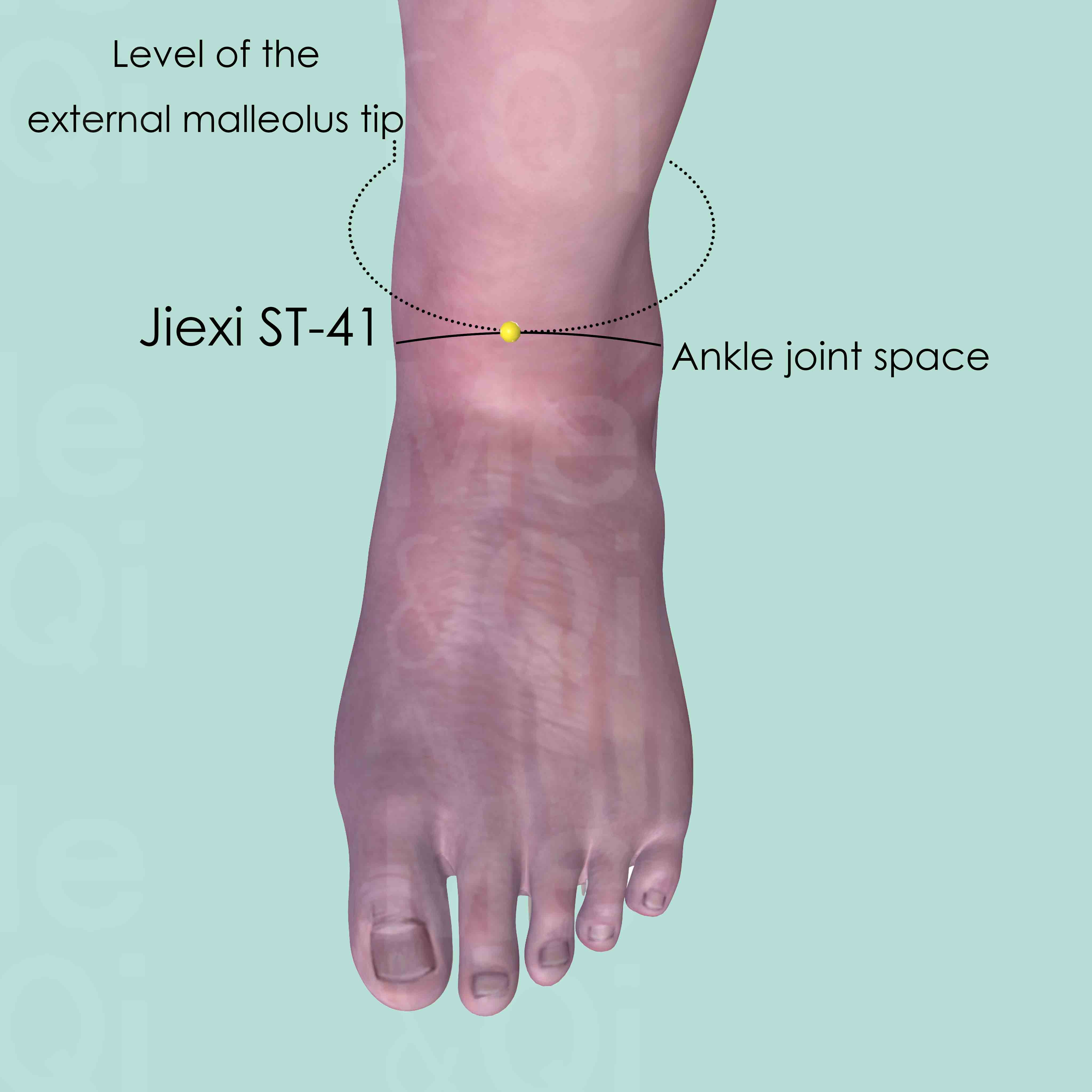
Jiexi ST-41
At the junction of the dorsum of the foot and leg, between the tendons of extensor digitorum and the extensor hallucis longus muscle. Approximately at the level of the tip of the external malleolus.
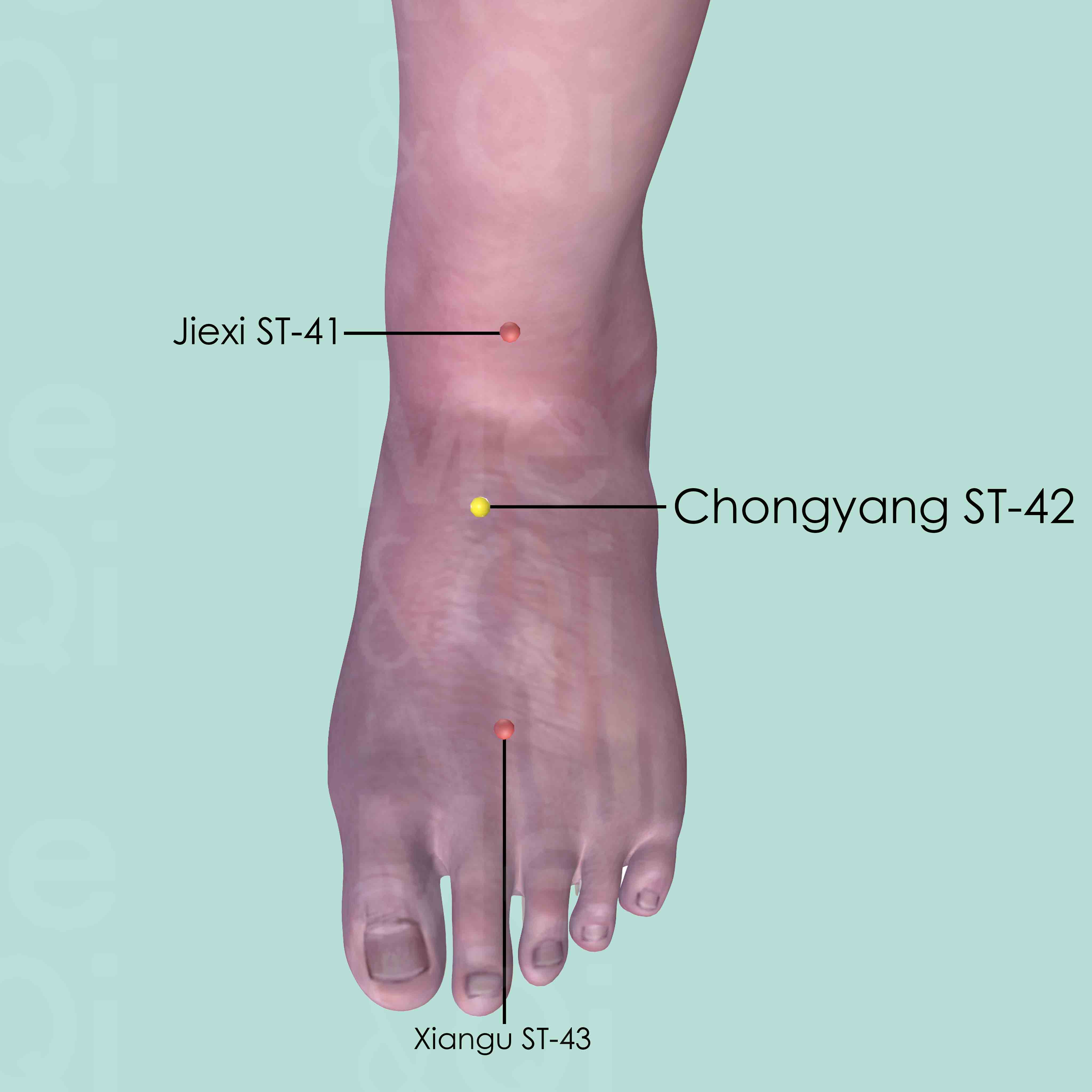
Chongyang ST-42
Distal to Jiexi ST-41, at the highest point of the dorsum of foot, between the tendons of the extensor hallucis longus and the extensor digitorum longus, directly lateral to the point where the dorsalis pedis artery may be palpated. The point is bordered proximally by the 2nd and 3rd metatarsal bones and distally by the 2nd and 3rd cuneiform bones.
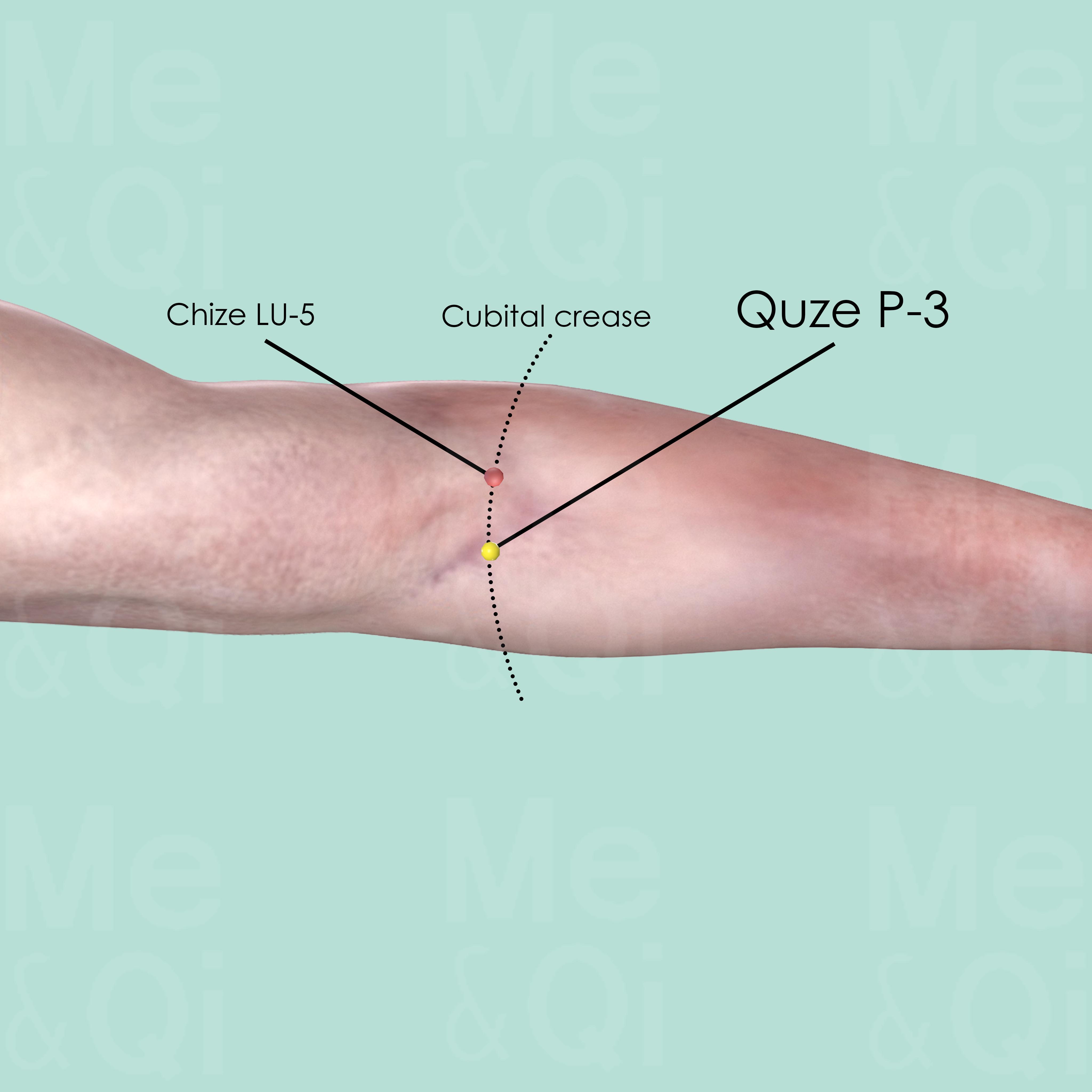
Quze P-3
On the transverse cubital crease, at the ulnar side of the tendon of biceps brachii muscle.
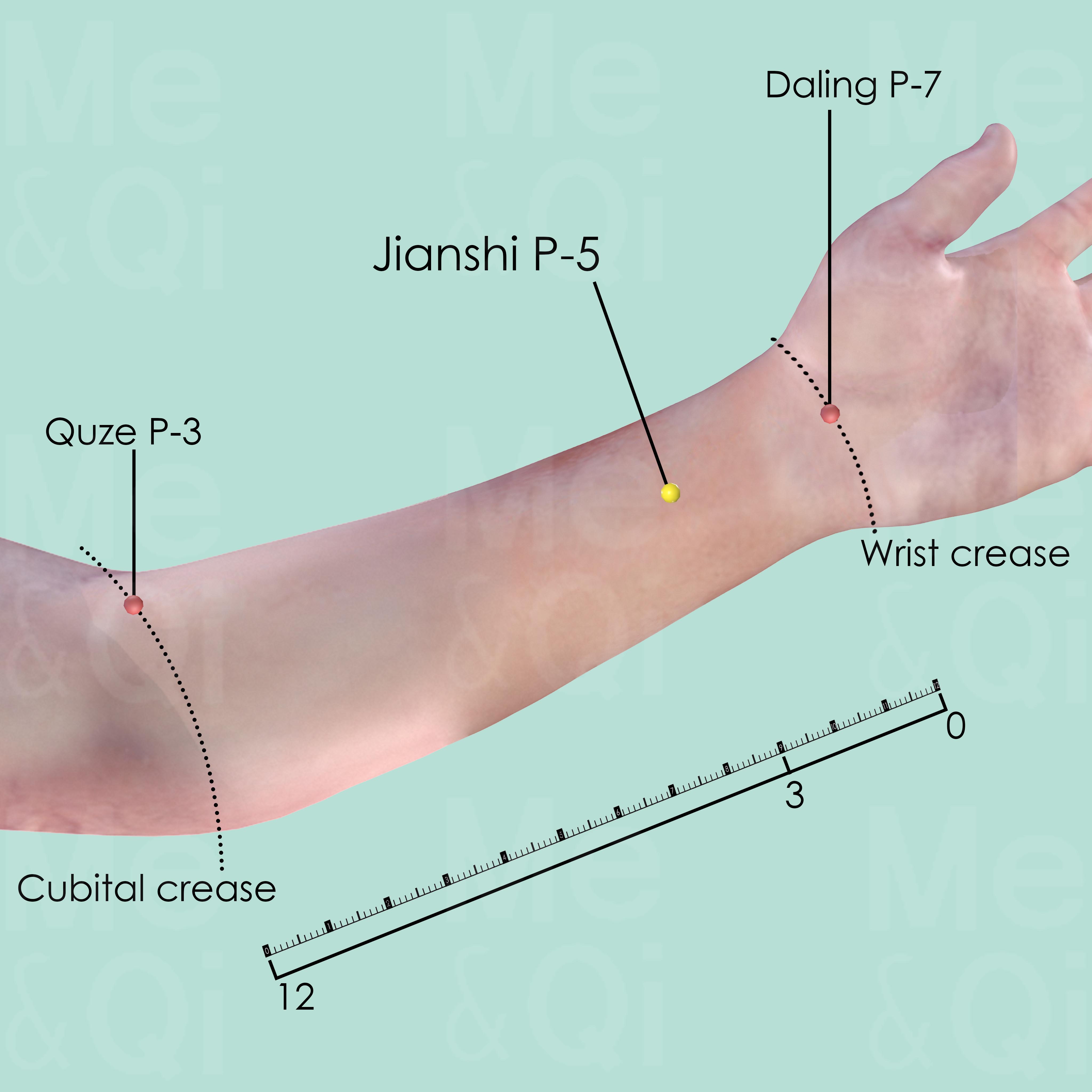
Jianshi P-5
3 cun above the transverse crease of the wrist, between the tendons of palmaris longus and flexor carpi radialis muscle.
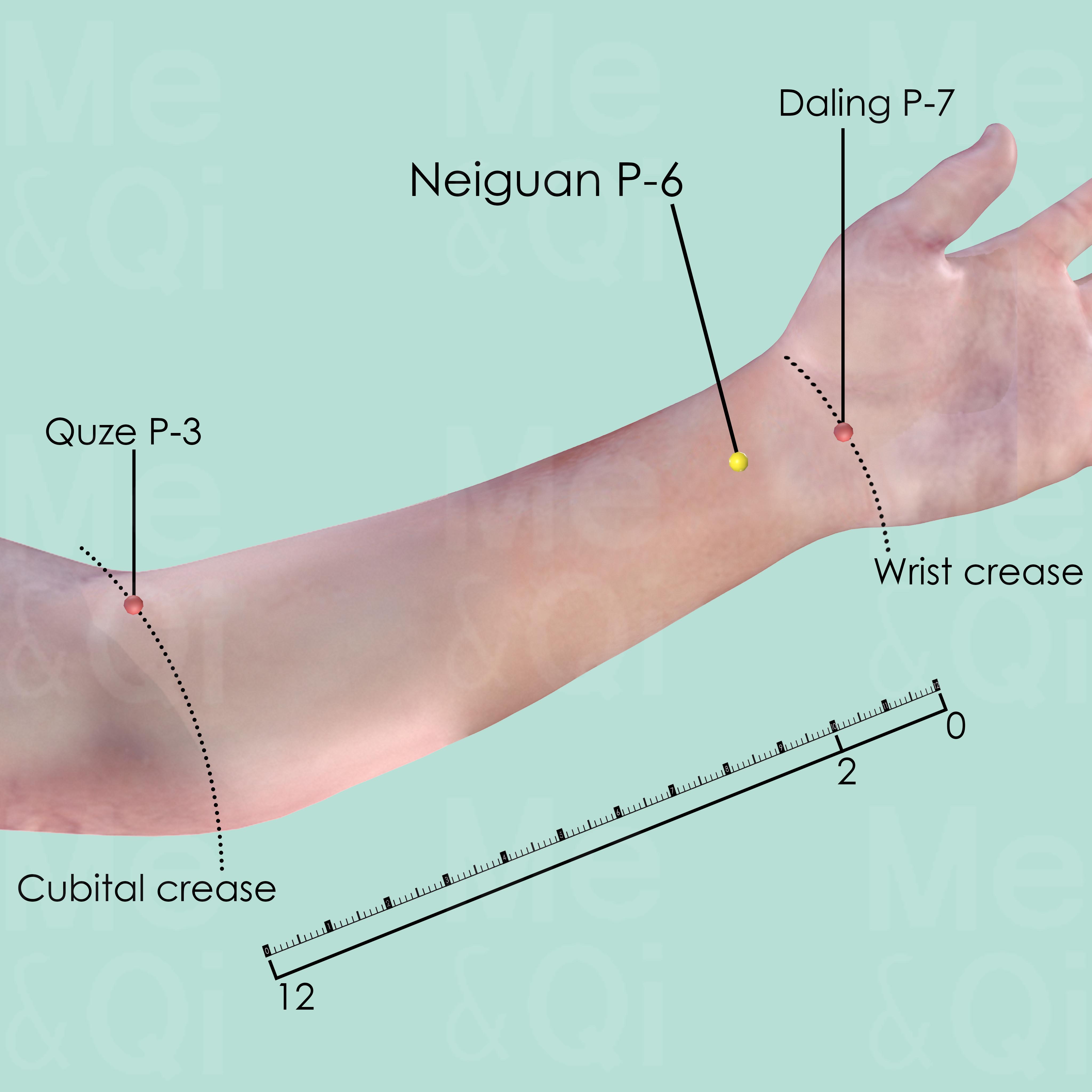
Neiguan P-6
2 cun above Daling P-7 on the transverse crease of the wrist, between the tendons of palmaris longus and flexor carpi radialis muscle.
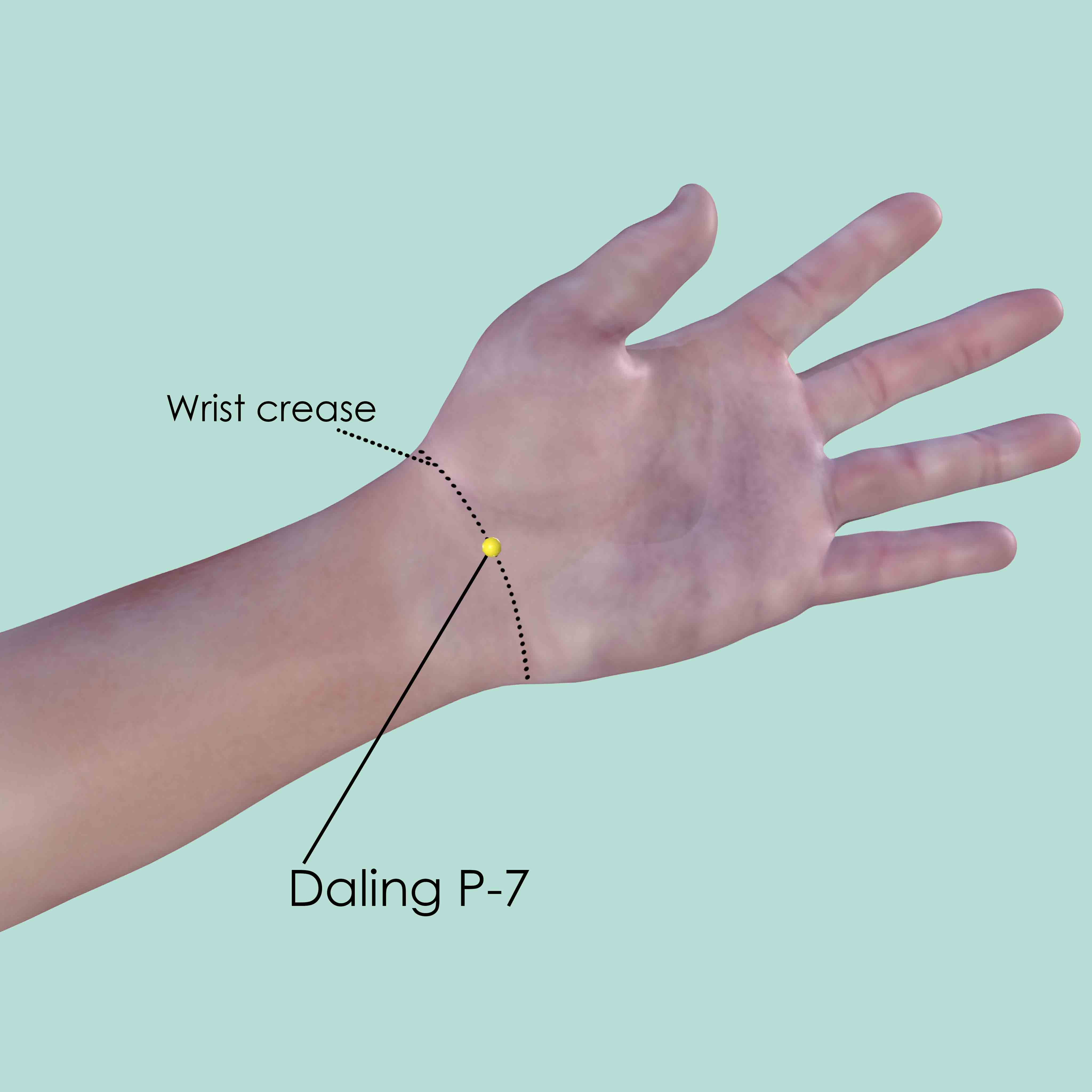
Daling P-7
In the depression in the middle of the transverse crease of the wrist, between the tendons of palmaris longus and flexor carpi radialis muscle.
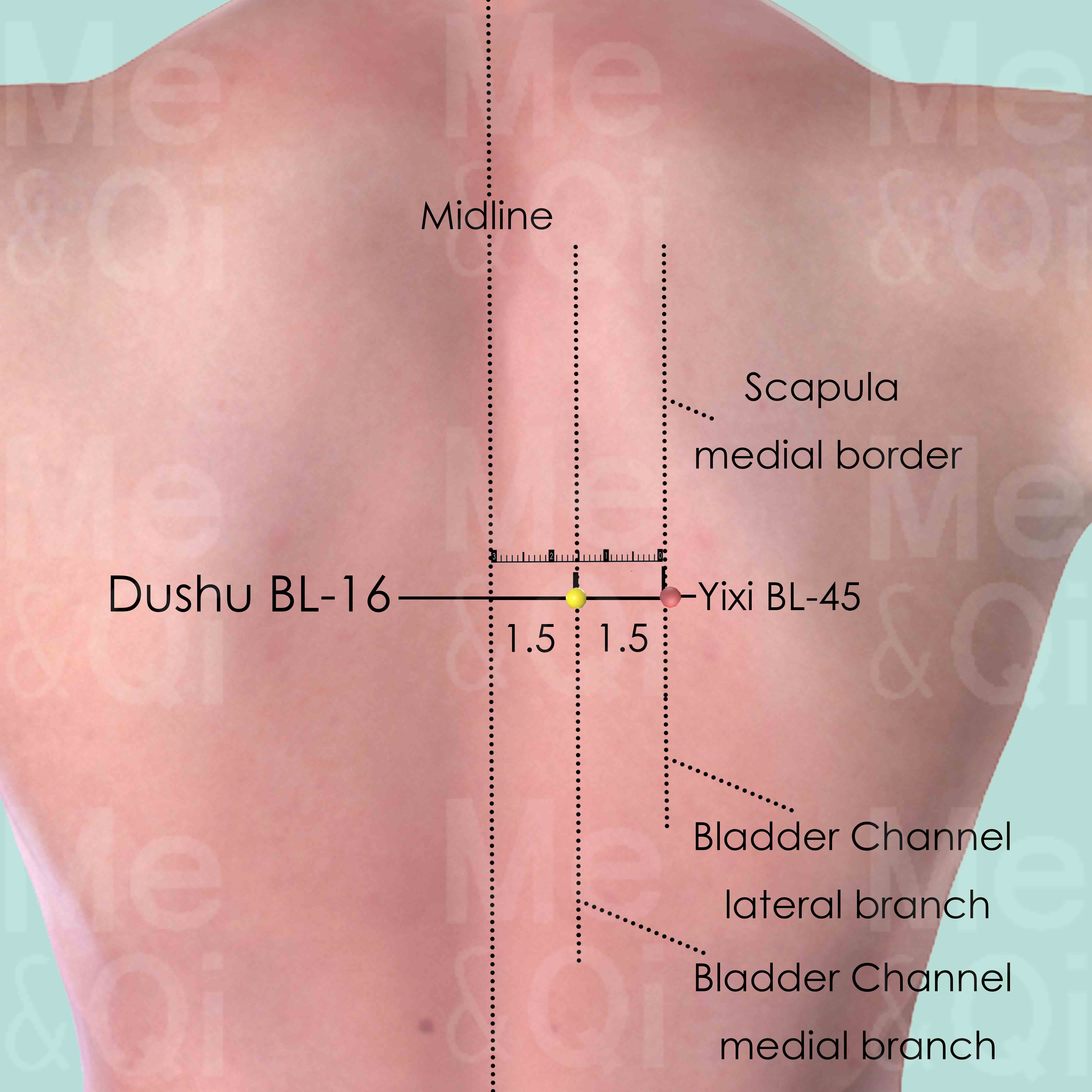
Dushu BL-16
1.5 cun lateral to the lower border of the spinous process of the 6th thoracic vertebra (T6).
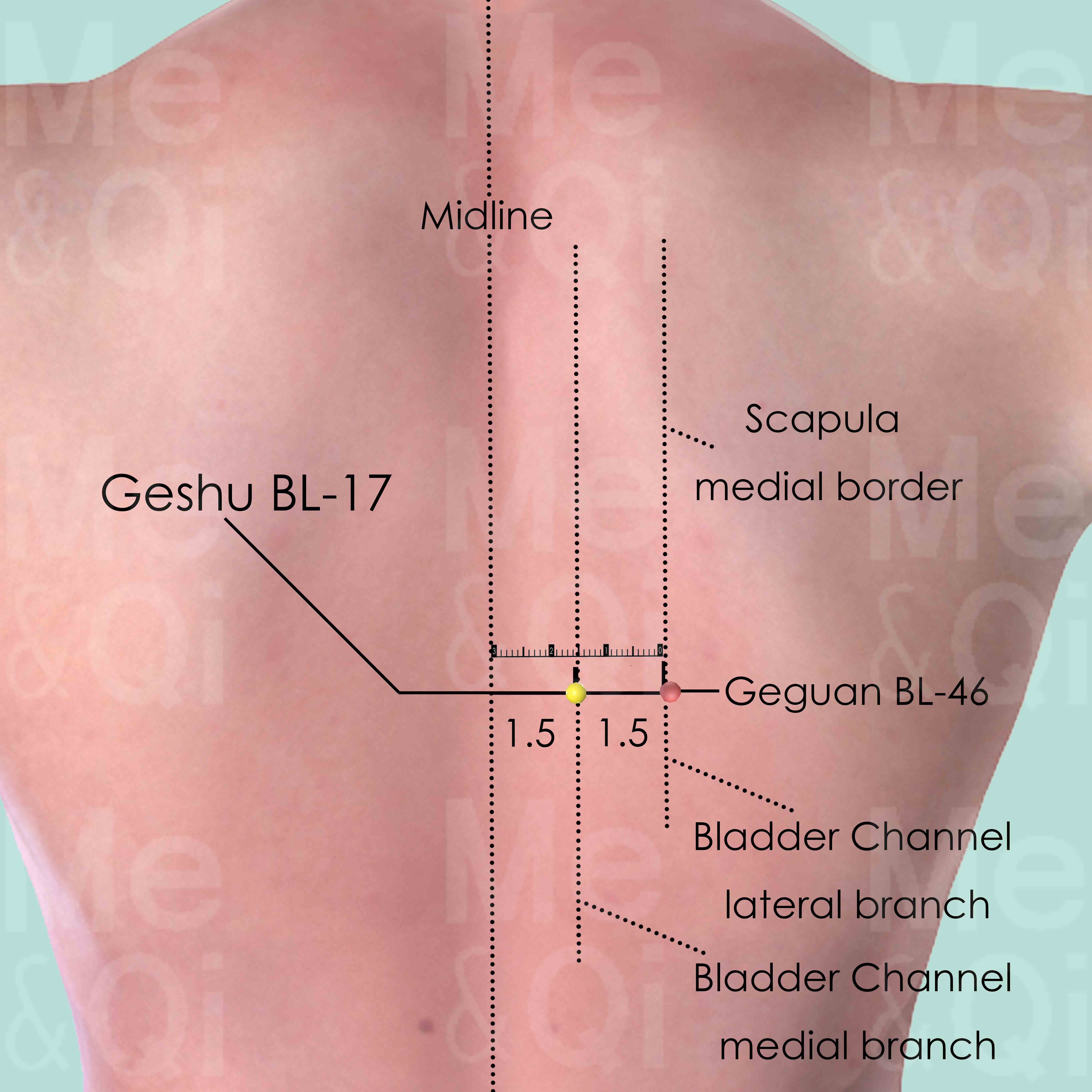
Geshu BL-17
1.5 cun lateral to the lower border of the spinous process of the 7th thoracic vertebra (T7).
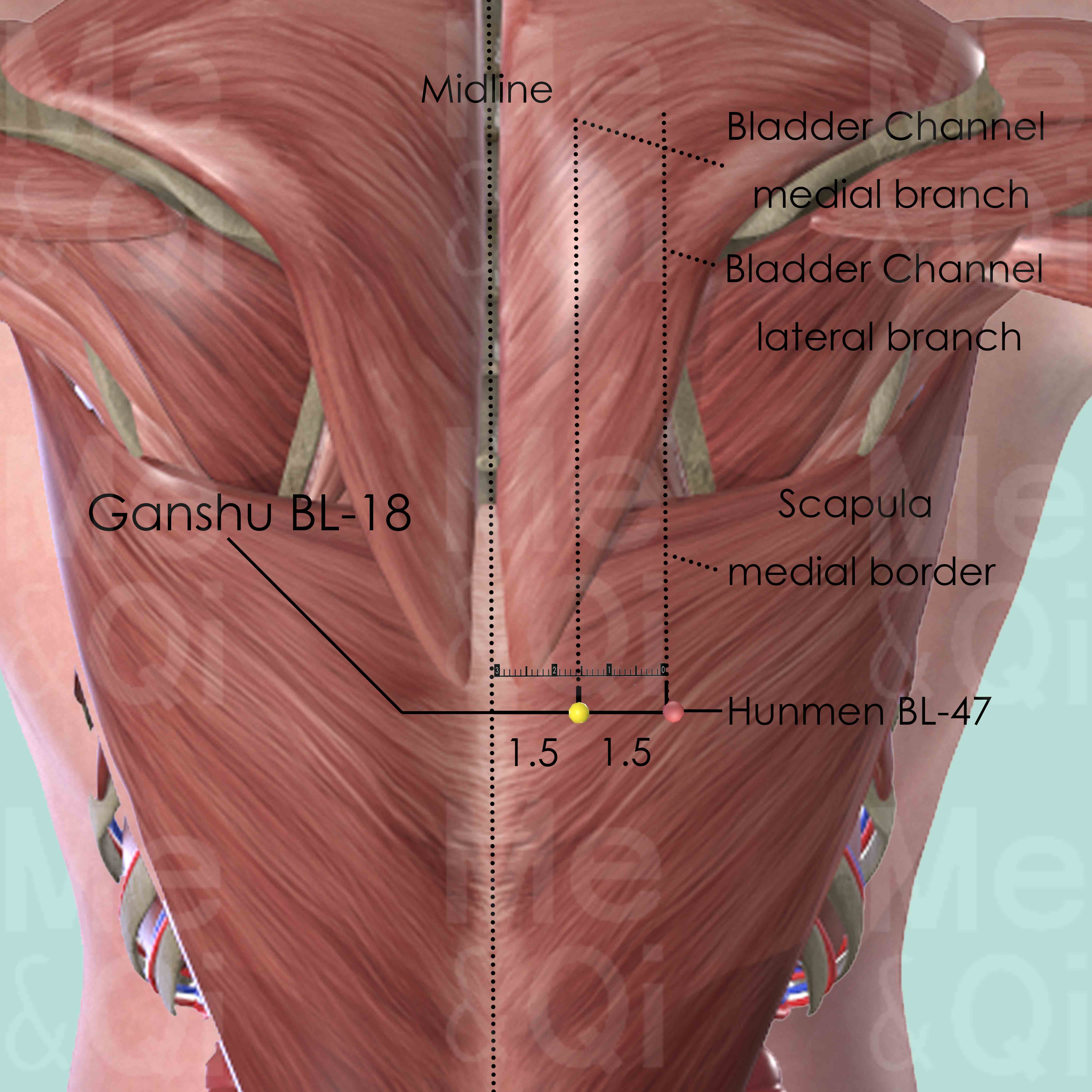
Ganshu BL-18
1.5 cun lateral to the lower border of the spinous process of the 9th thoracic vertebra (T9).
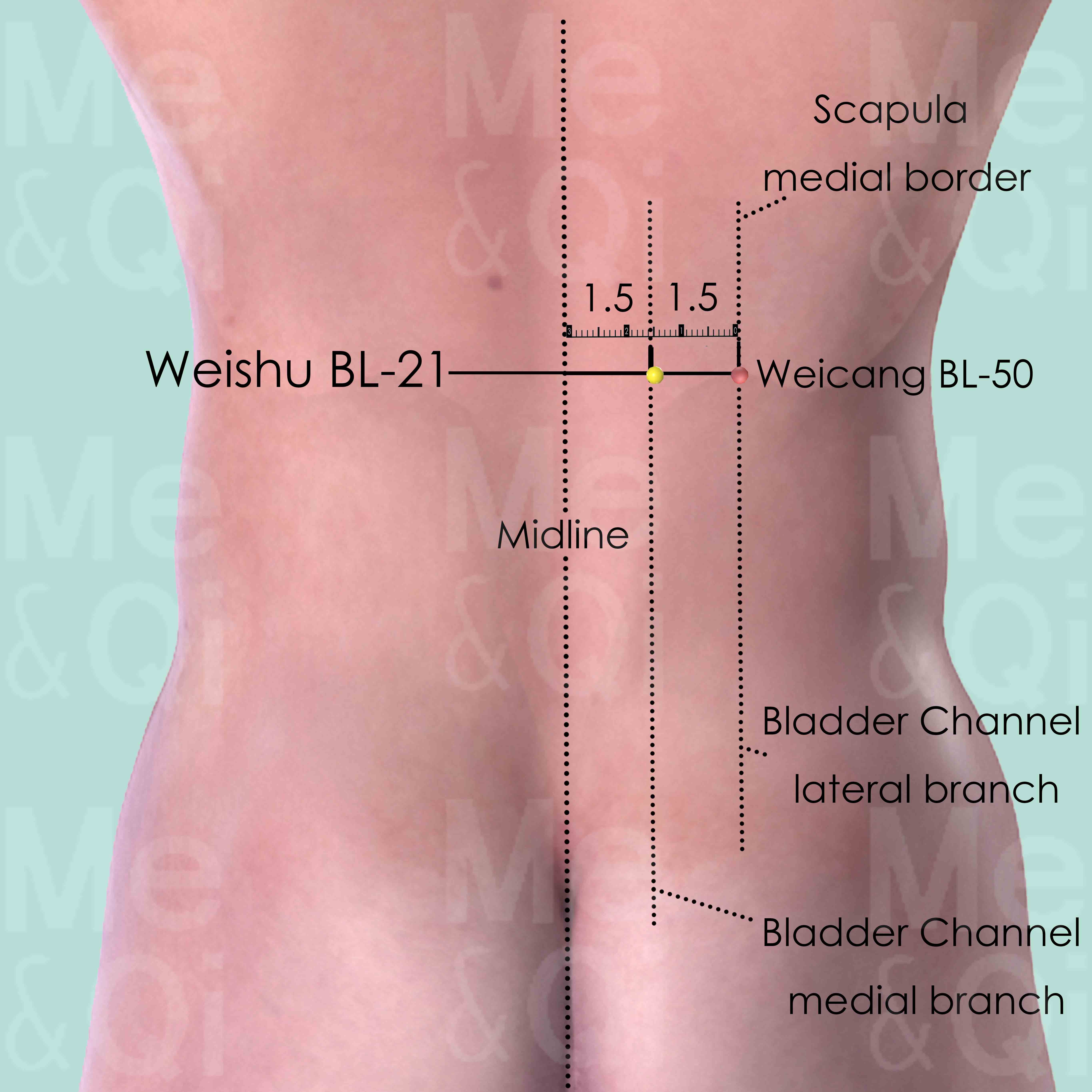
Weishu BL-21
1.5 cun lateral to the lower border of the spinous process of the 12th thoracic vertebra (T12).
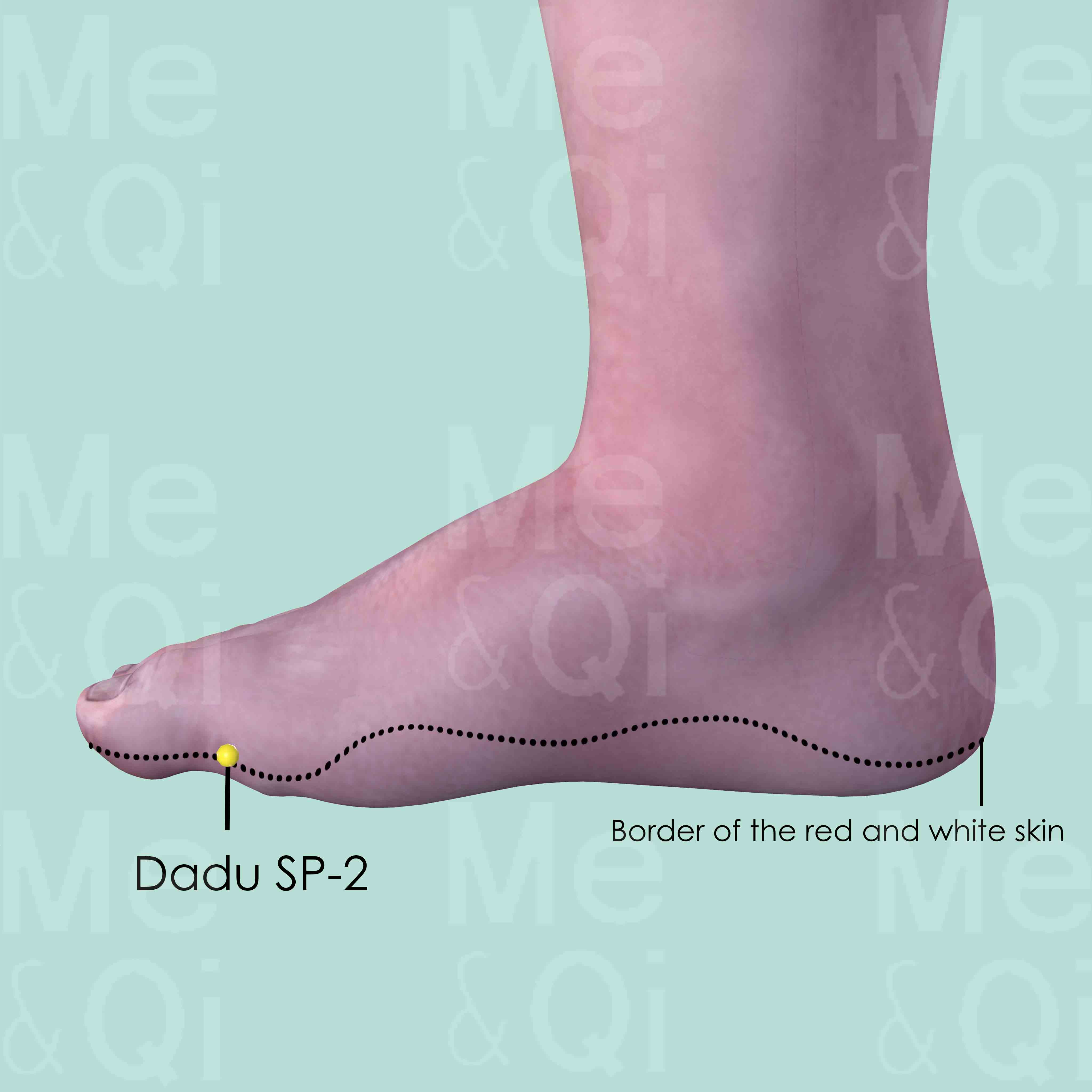
Dadu SP-2
On the medial aspect of the big toe, at the junction of the shaft and the base of the proximal phalanx, distal to the 1st metatarsophalangeal joint.
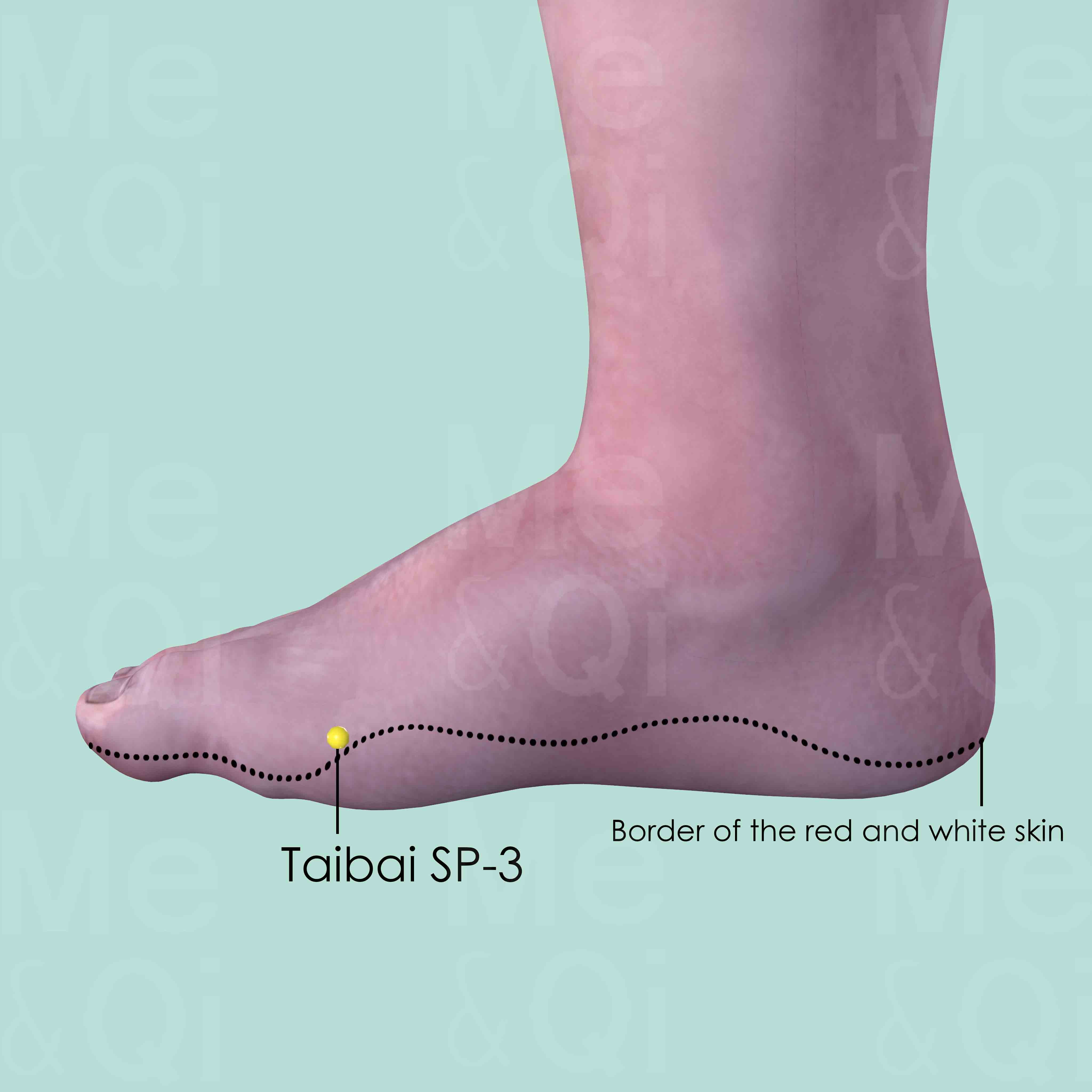
Taibai SP-3
Proximal and inferior to the head of the 1st metatarsal bone, at the border of the red and white skin.
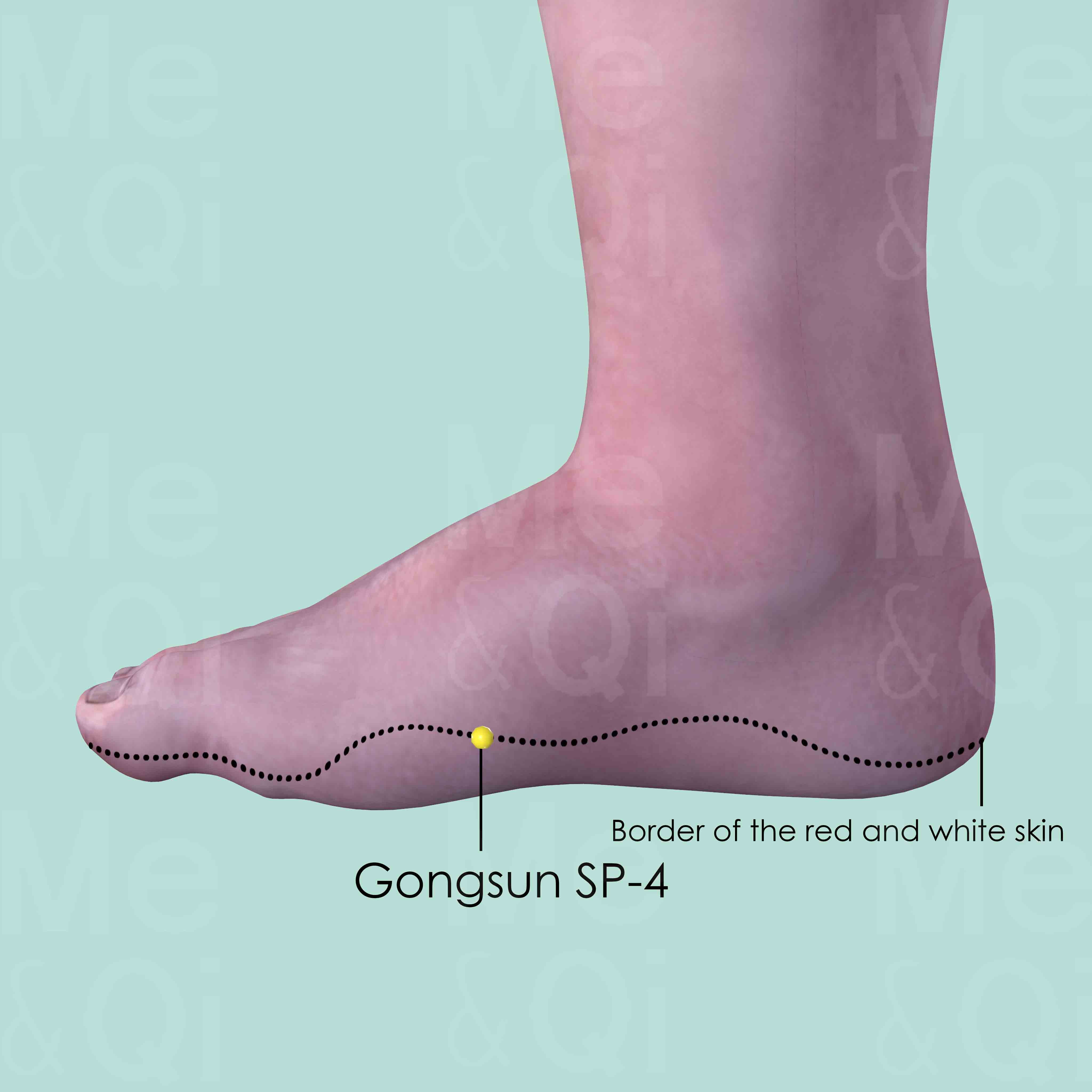
Gongsun SP-4
In the depression distal and inferior to the base of the 1st metatarsal bone, at the border of the red and white skin.
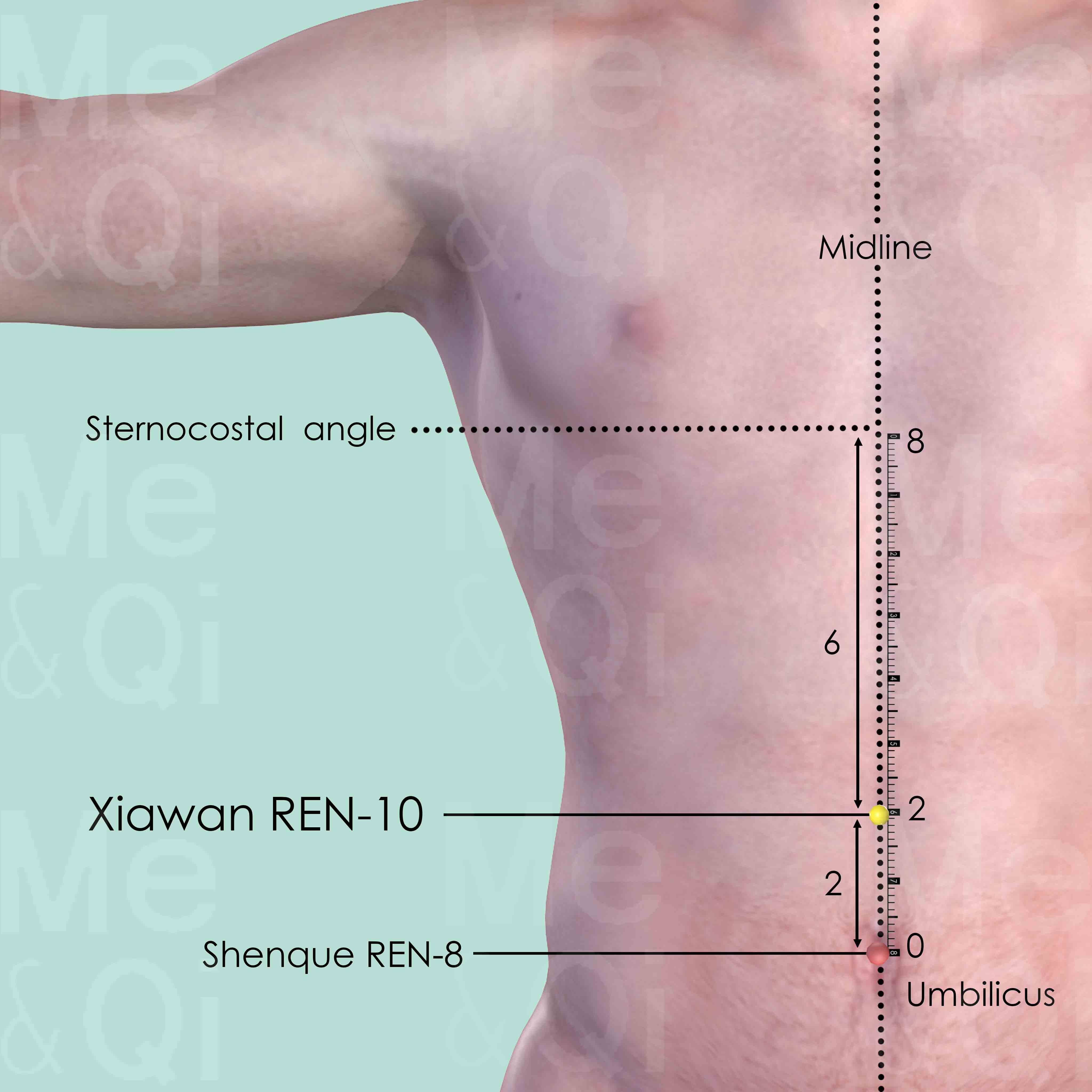
Xiawan REN-10
On the midline of the abdomen, 2 cun above the umbilicus and 6 cun below the sternocostal angle.
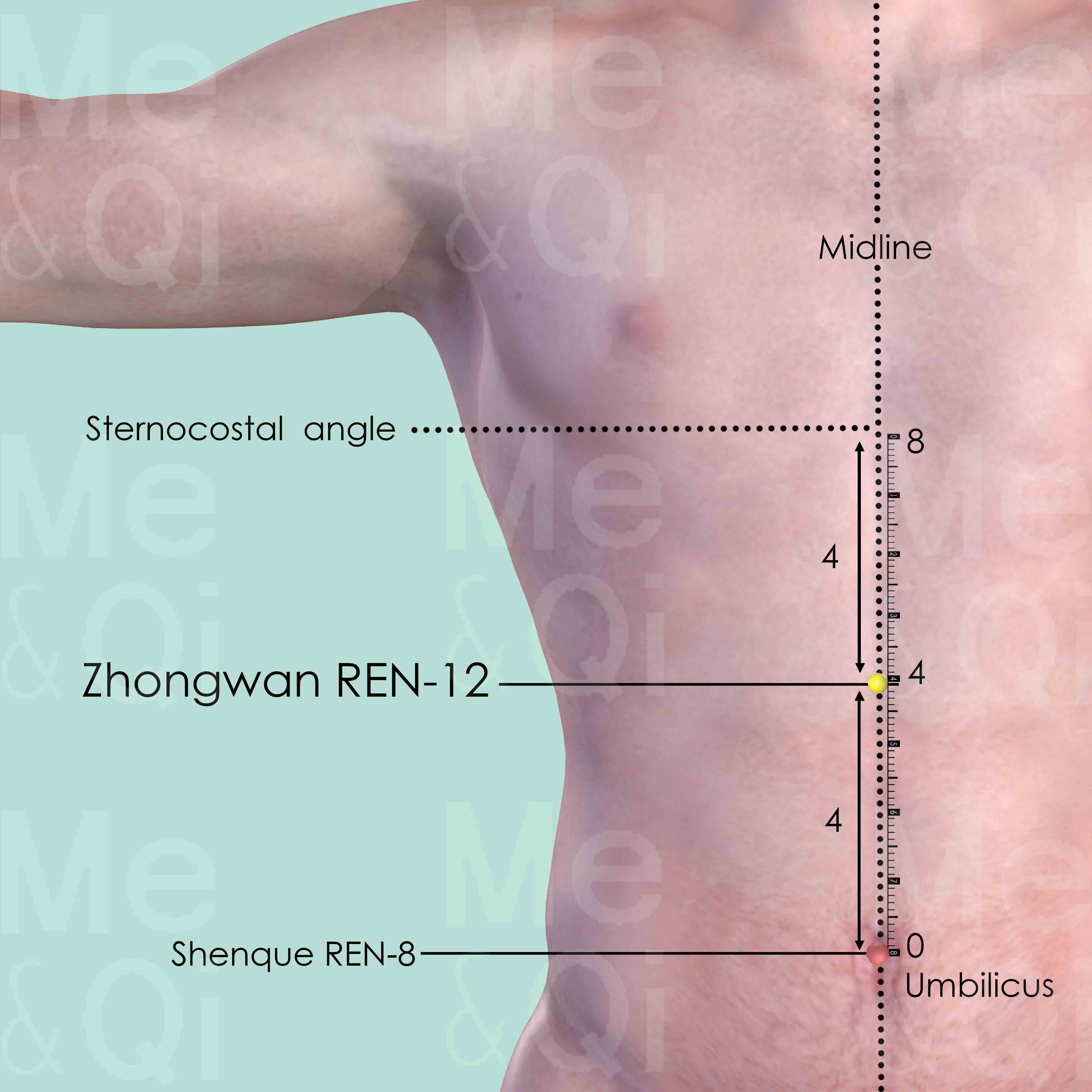
Zhongwan REN-12
On the midline of the abdomen, 4 cun above the umbilicus and 4 cun below the sternocostal angle.
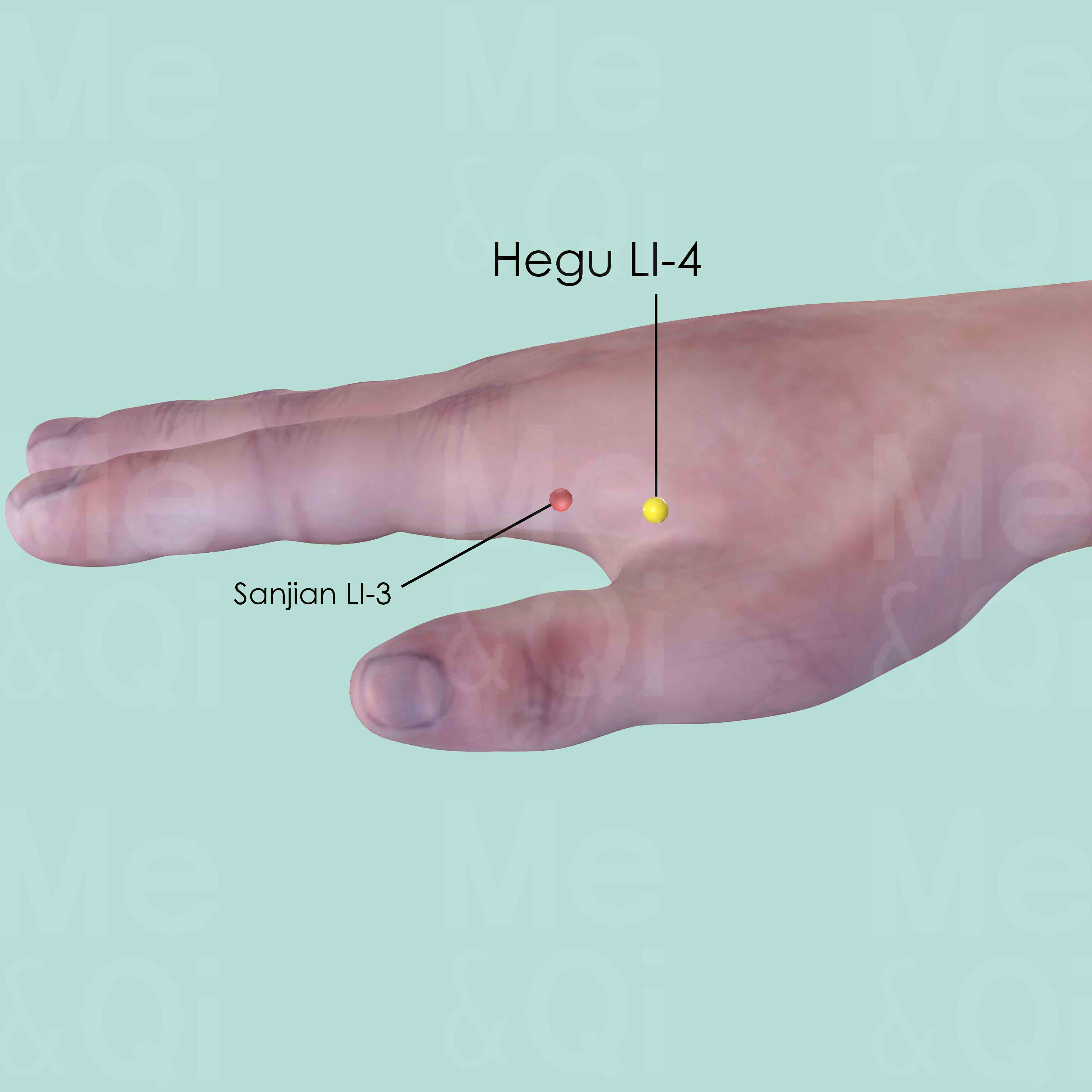
Hegu LI-4
Between the 1st and 2nd metacarpal bones, approximately in the middle of the 2nd metacarpal bone on the radial side.
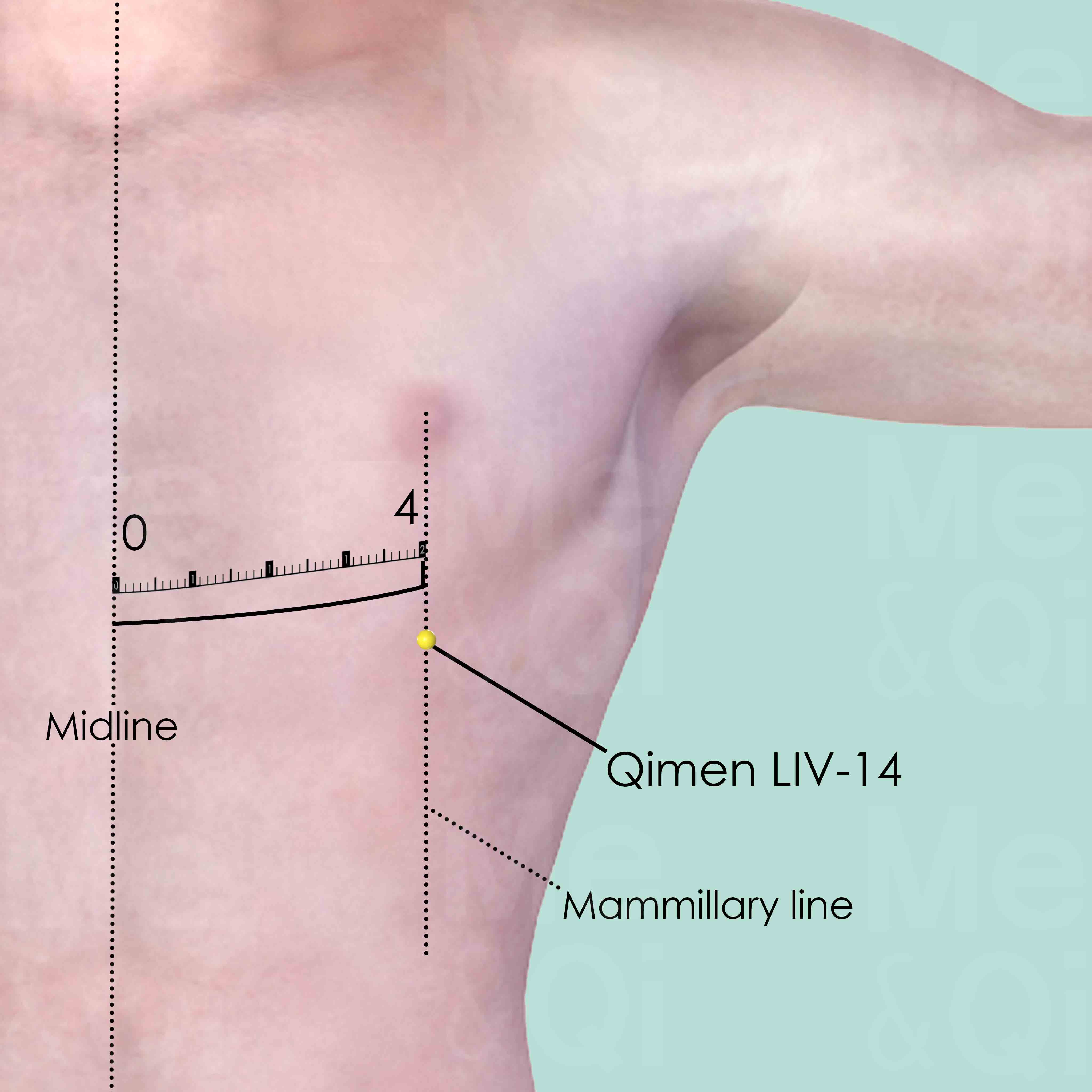
Qimen LIV-14
On the mammillary line, two ribs below the nipple, in the 6th intercostal space, 4 cun lateral to the midline. Please note that there is an alternative location for LIV-14 at the lower edge of the ribcage in line with the nipple or, in women, 4 cun from the midline. In fact, one could look upon these as two separate points. The one in the intercostal space is used more for Channel problems. While the one at the lower edge of the ribcage is used more for Organ problems.
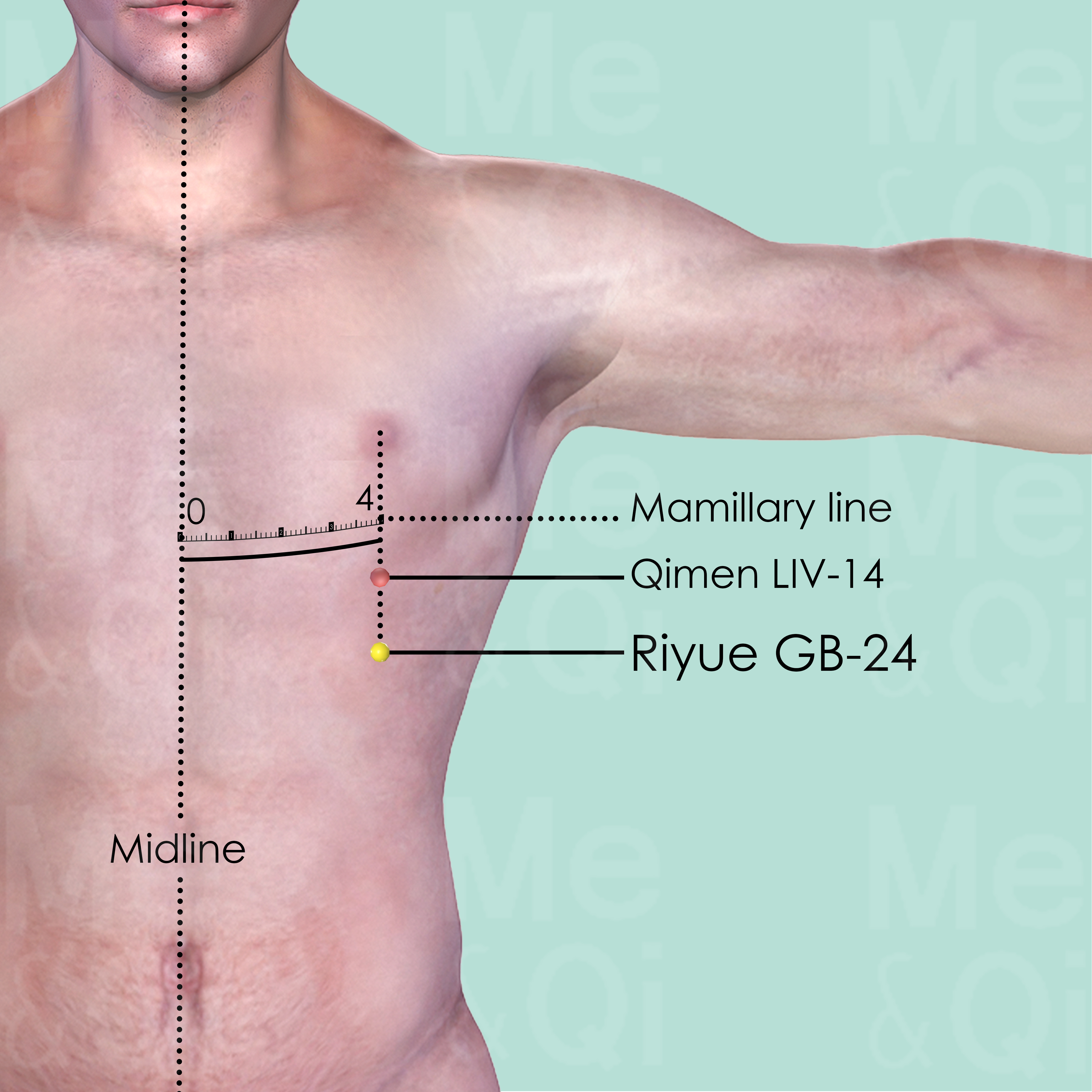
Riyue GB-24
On the mamillary line which is 4 cun lateral to the anterior midline, in the 7th intercostal space, 1 intercostal space below Qimen LIV-14.
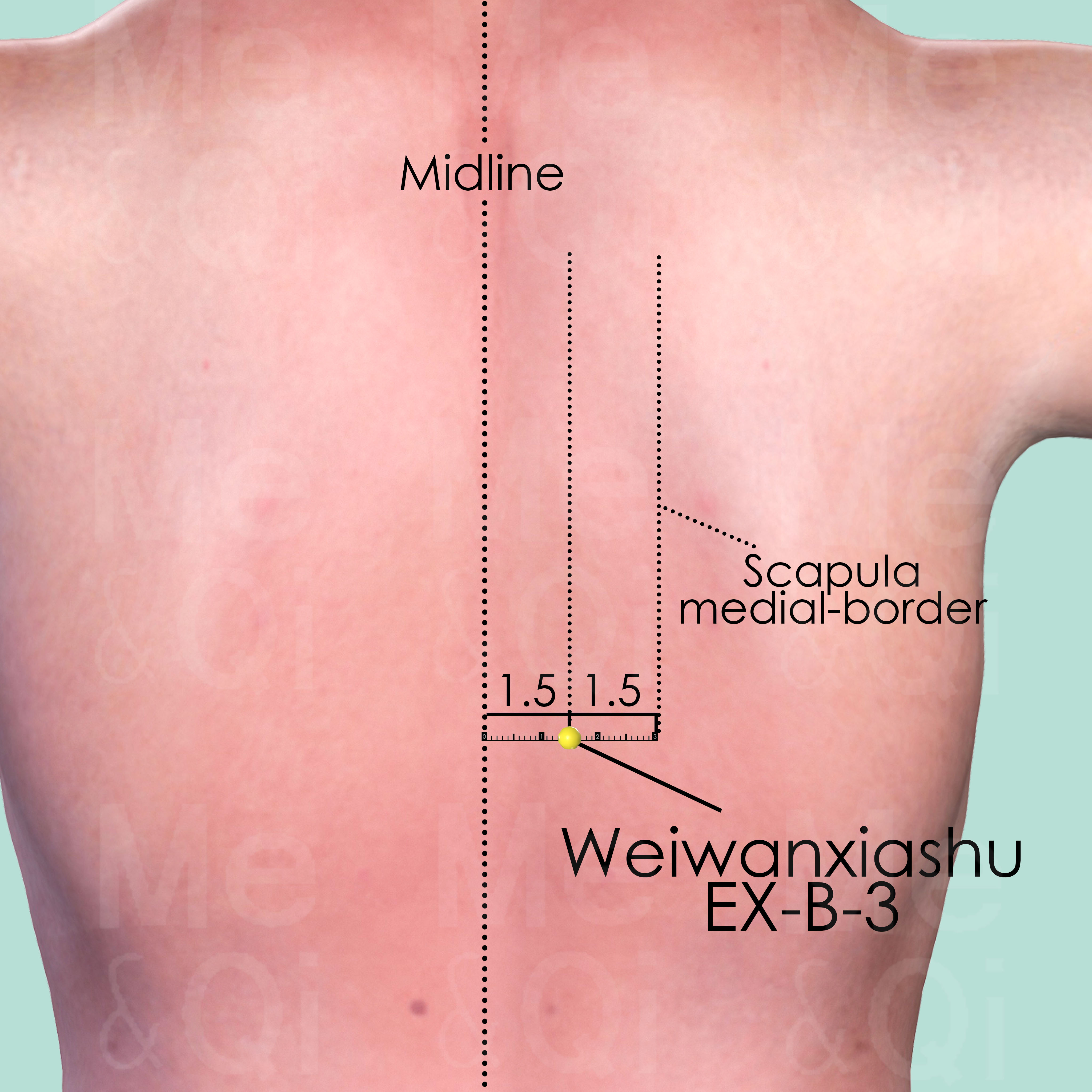
Weiwanxiashu EX-B-3
1.5 cun lateral to the lower border of the spinous process of the 8th thoracic vertebra (T8).

